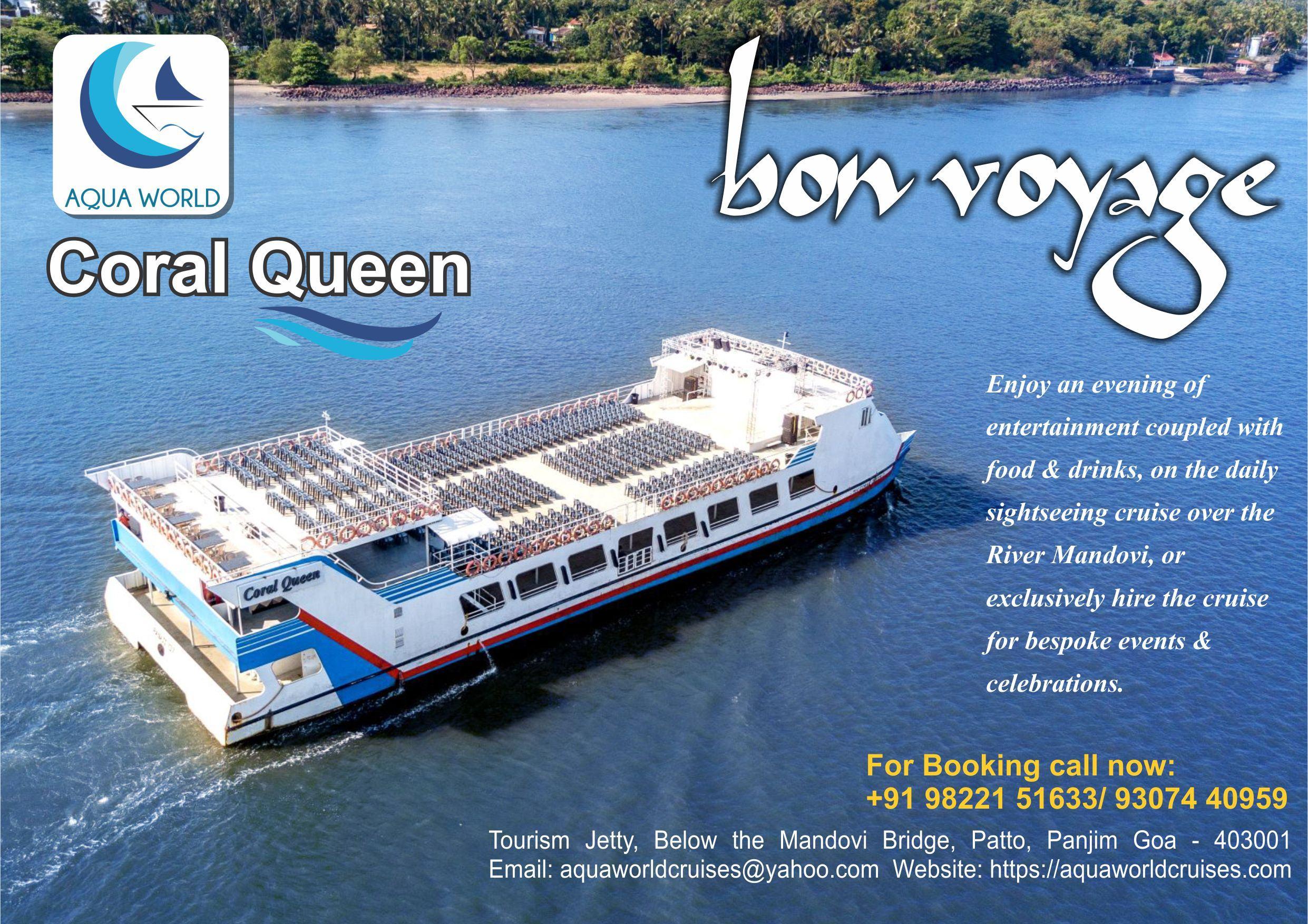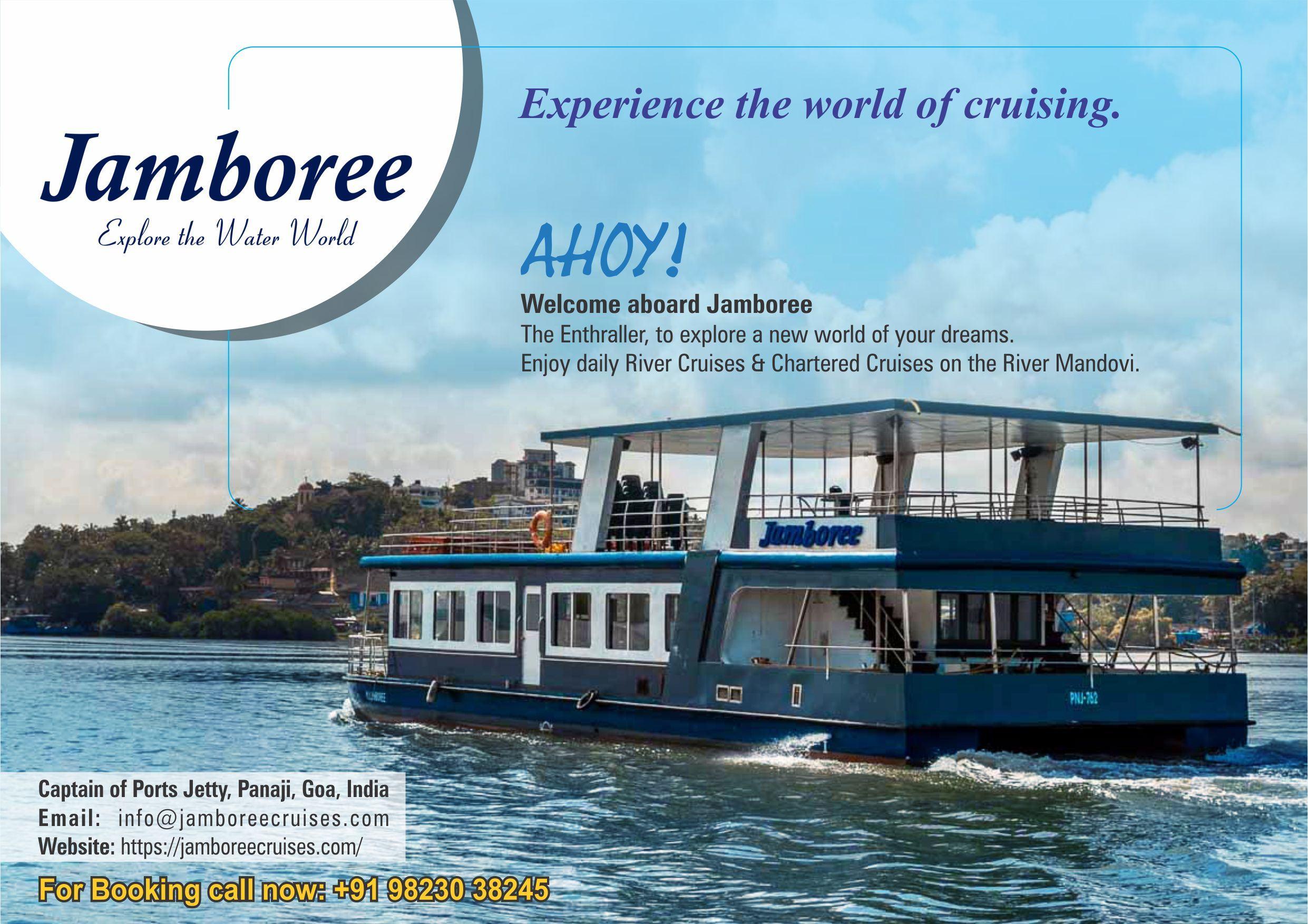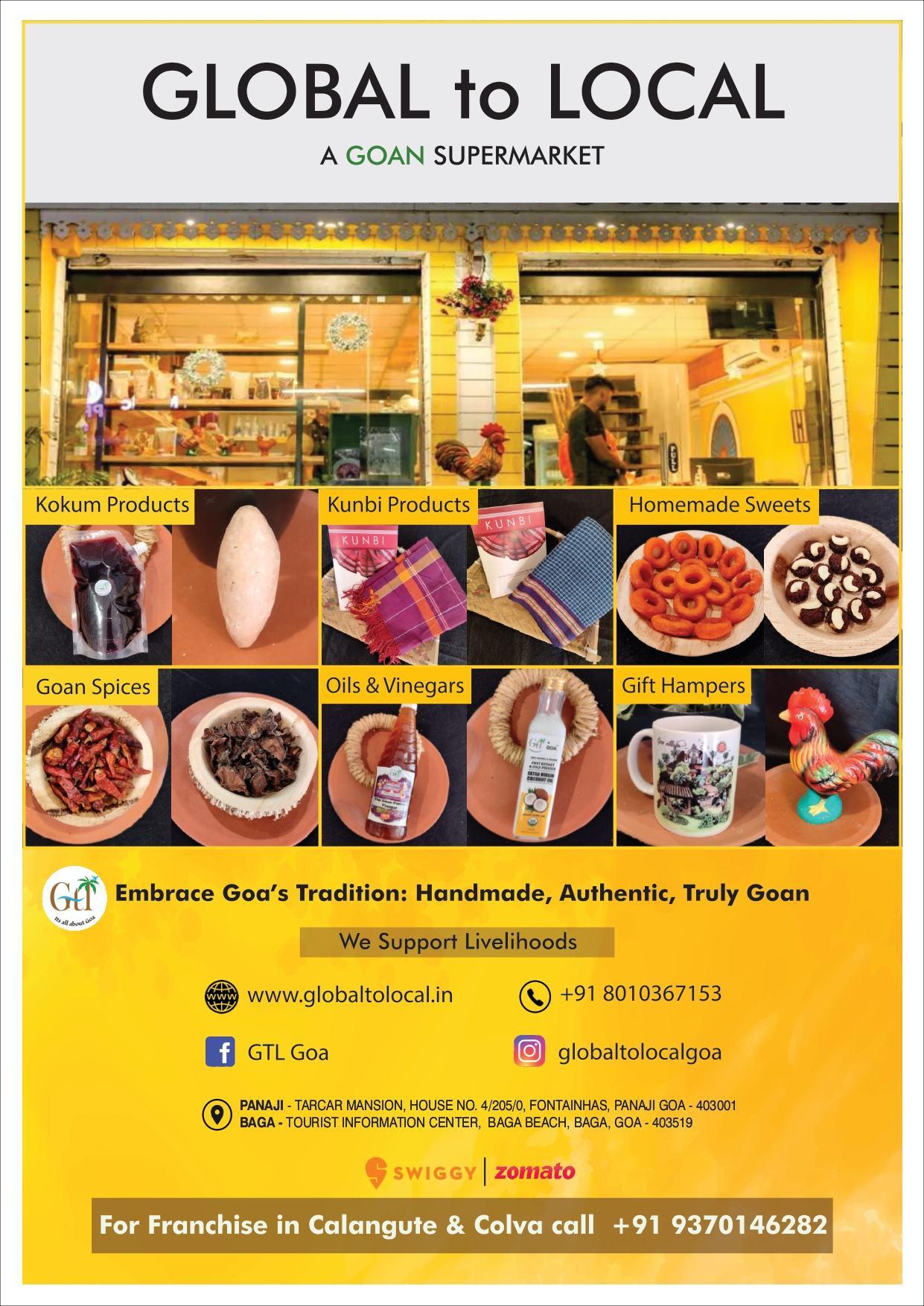Volume 4 Issue 10 October 2025


Volume 4 Issue 10 October 2025

Goa’s techno DJ crafting soulful, minimalist electronic music with global appeal.
Desmond Fernandes
Goan creator redefining Indian horror through real-life stories and emotional depth.
Self-taught Goan artist expressing emotions through intuitive, textured, and evolving art.
Versatile Goan emcee delivering energetic, engaging, and storydriven event experiences.


If holidays are inspired by nature and your thirst for rustic solitude and inner peace, Lua Nova is the hotel your heart was yearning for.
Located at Goa's celebrated holiday capital at Baga, it overlooks a beautiful Canvas of village Goa, just 5 minutes walk from the Baga Beach.

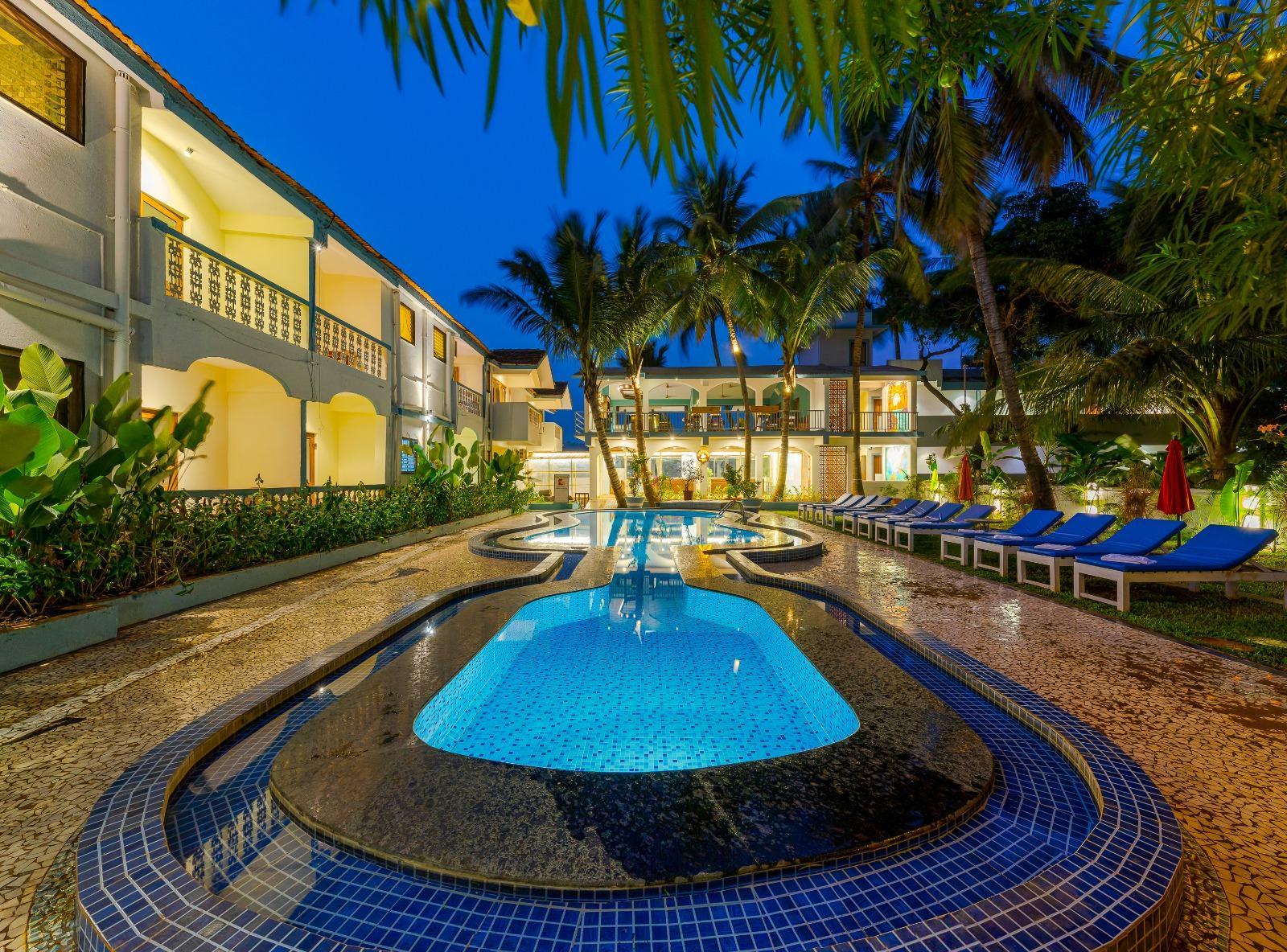

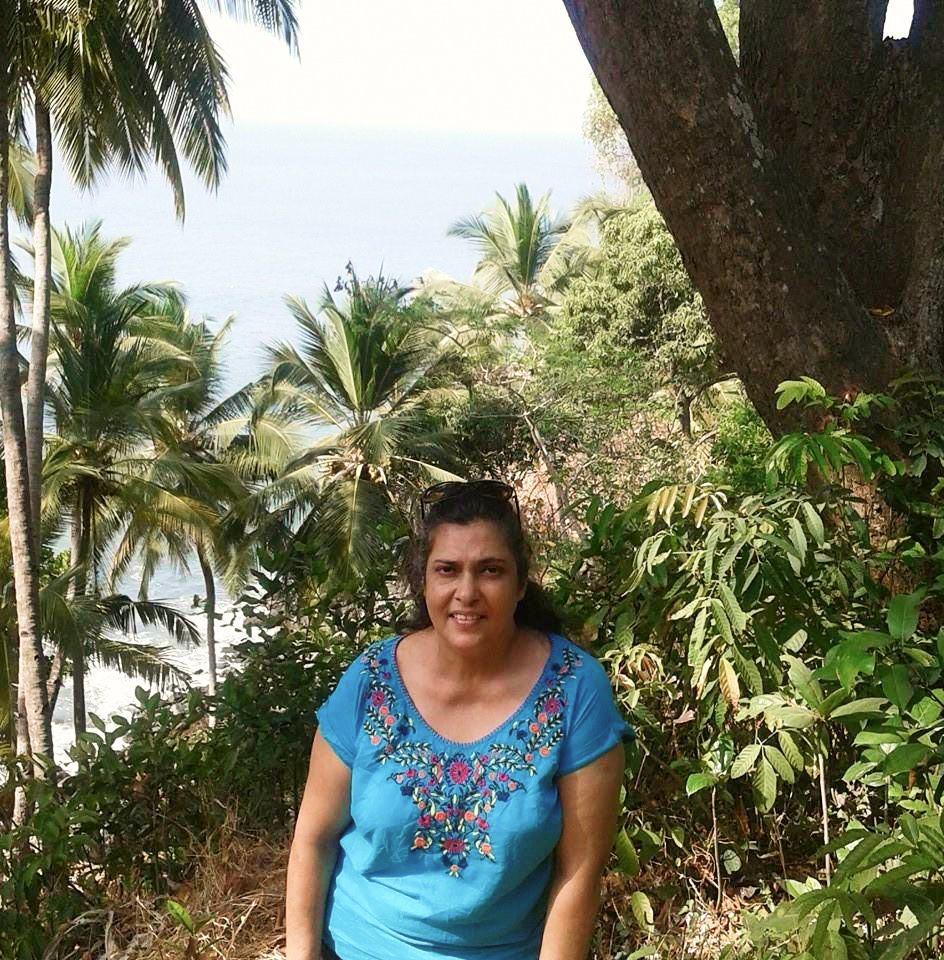
October in Goa brings with it a beautiful blend of calm and celebration — golden sunsets, festive air, and the creative pulse of a community that continues to evolve, inspire, and innovate. As the monsoon gently retreats, Goa steps into a season of reflection and renewal — a perfect time to spotlight stories that capture its rhythm and resilience.
In this edition of Being Goan, our cover feature spotlights Shaun Moses, the Goabased techno producer and DJ redefining electronic music with his soulful, minimalist sound. From local clubs to global stages, Shaun’s journey embodies authenticity, persistence, and Goa’s evolving creative spirit.
We step into the world of Desmond Fernandes, creator of Dez Horror Stories, who transforms real-life experiences and Goan folklore into gripping horror narratives. Blending emotion and storytelling, he’s redefining India’s paranormal content — one chilling tale at a time.
From sound and storytelling to visual art, we meet Sachi Kurtarkar Kamat, a self-taught Goan artist whose intuitive, layered works turn raw emotions into vibrant canvases
capturing both vulnerability and strength in every stroke.
Next, we have Hensika Fernandes, a dynamic Goan emcee who commands the stage with confidence and charm. Her adaptability and engaging presence make every event memorable — proving storytelling goes far beyond pages or
Breaking barriers in the skies, Captain Keziah Fernandes, Goa’s first female pilot with FLY91, inspires with her journey from Cuncolim to the cockpit, fuelling the dreams of young Goan women ready to soar.
Parixit Pai Fondekar of Kamaxi Group champions skill-based learning over traditional degrees, aiming to align India’s education with real-world needs and prepare youth for the industries of tomorrow.
For those eager to rediscover Goa, our feature on its museums takes readers through time — from ancient artefacts and naval history to folk traditions and Christian art, each exhibit telling a chapter of Goa’s heritage.
Join us in celebrating Goa’s vibrant stories, from entrepreneurs to artists, each contributing uniquely to our community. Let their journeys inspire you to follow your passions and pursue your dreams with determination.
Well, that's all I have for you from my desk this month. I hope you enjoy reading this month's issue of our e-magazine. Do share it with your friends all across the globe.
Until next month, cheers!
Jessyl Fernandez Editor
01 Shaun Moses
02 Desmond Fernandes
03 Sachi Kurtarkar Kamat
04 Hensika Fernandes
05 From Cuncolim to the Cockpit, Goa's Keziah Fernandes' Flight Path with FLY91
06 Why Skills Are the New Degree: Bridging India’s Skilling Gap
07 Goa Museums
Goa, the tiniest state on the western coast of India, boasts golden pristine beaches, palmfringed avenues, flavourful food, delicious Portuguese-influenced sweets, and warm, hospitable people. Also known as the Ibiza of India for its partying. A tropical paradise of flora and fauna, from the very famous 'almi' (mushrooms) endemic to its forests, that grow only on the red mud anthills, to the solar prawns that are fished immediately after the monsoons, Goa is unique. Tourists are also attracted to Goa for its cultural heritage - from the famous old Portuguese churches like Se Cathedral in Old Goa, the 16th Century Safa Masjid in Ponda and Shree Mangesha Temple in Mardol, the legendary Arvalem or Pandava Caves where the Pandavas of the Mahabharat fame lived, to its two unique festivalsCarnival and Shigmo. Goa plays host to many festivals - the International Film Festival of India that promotes cinema, the Serendipity Art Festival, Sunburn Music Festival, The Grape Escapade to name a few. To showcase this varied heritage of culture, art, tradition, food, and people, in 2015 ItsGoa was born. The main aim was to make it the premier portal for all things Goa. We were able to showcase Goa like never before. Soon our blog-based website transcended the virtual space, with the ItsGoa magazine – a sought-after resource for visitors to Goa from countries like Norway, Germany, UK, USA, UAE, etc.
Chief Editor
Jessyl Fernandez
Sales
Donald Fernandez
Content & Social Media
Saviola Dias
Renata Fernandes
Graphics & Layout
Latisha Govekar
For advertising queries: +91 7887330620 / 9370502124
ItsGoa Media Group
Nordic Intent HQ - Floor 3, PDA Colony, Porvorim, Goa 403521
Email: mail@itsgoa.com
Website: itsgoa.com
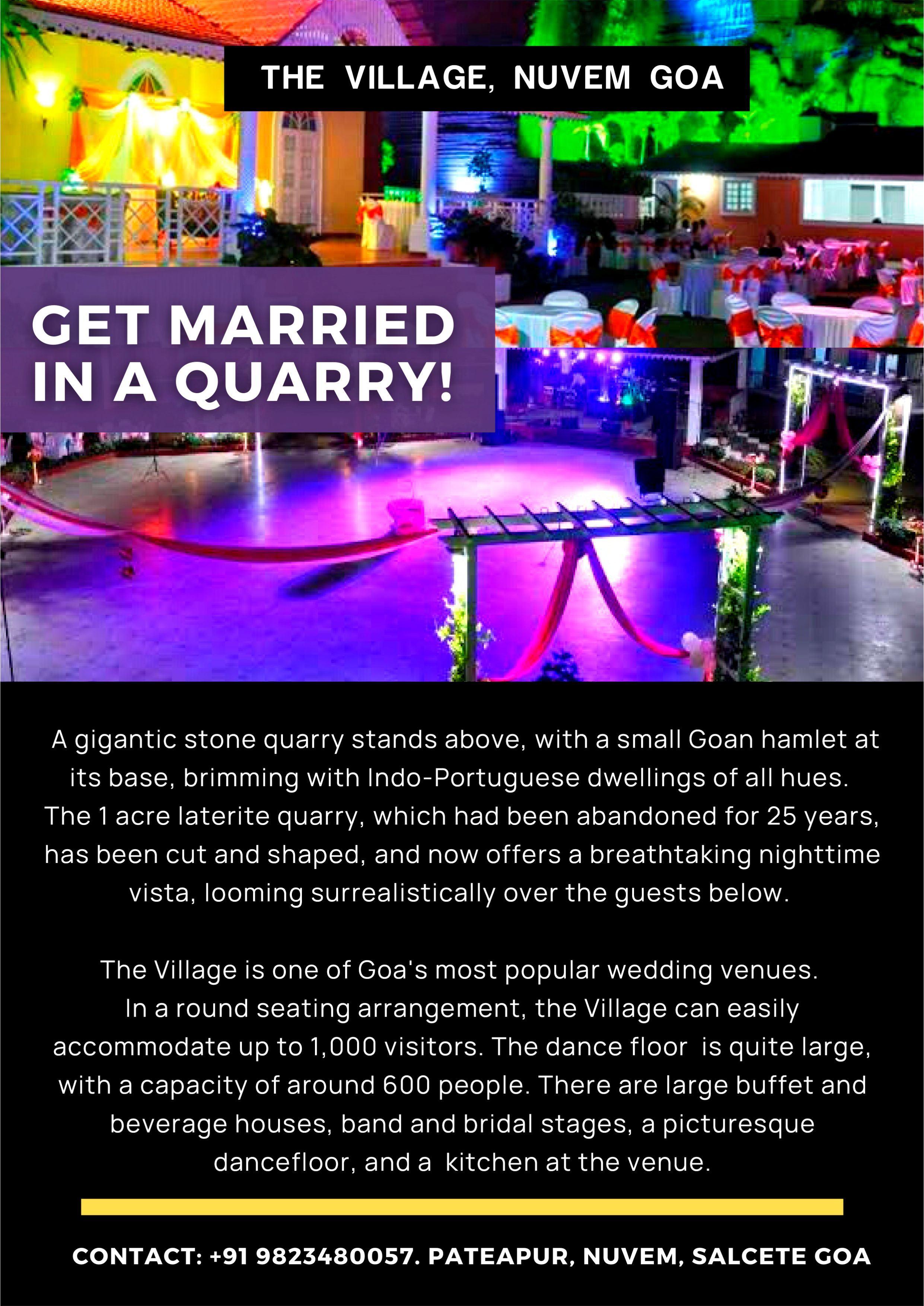
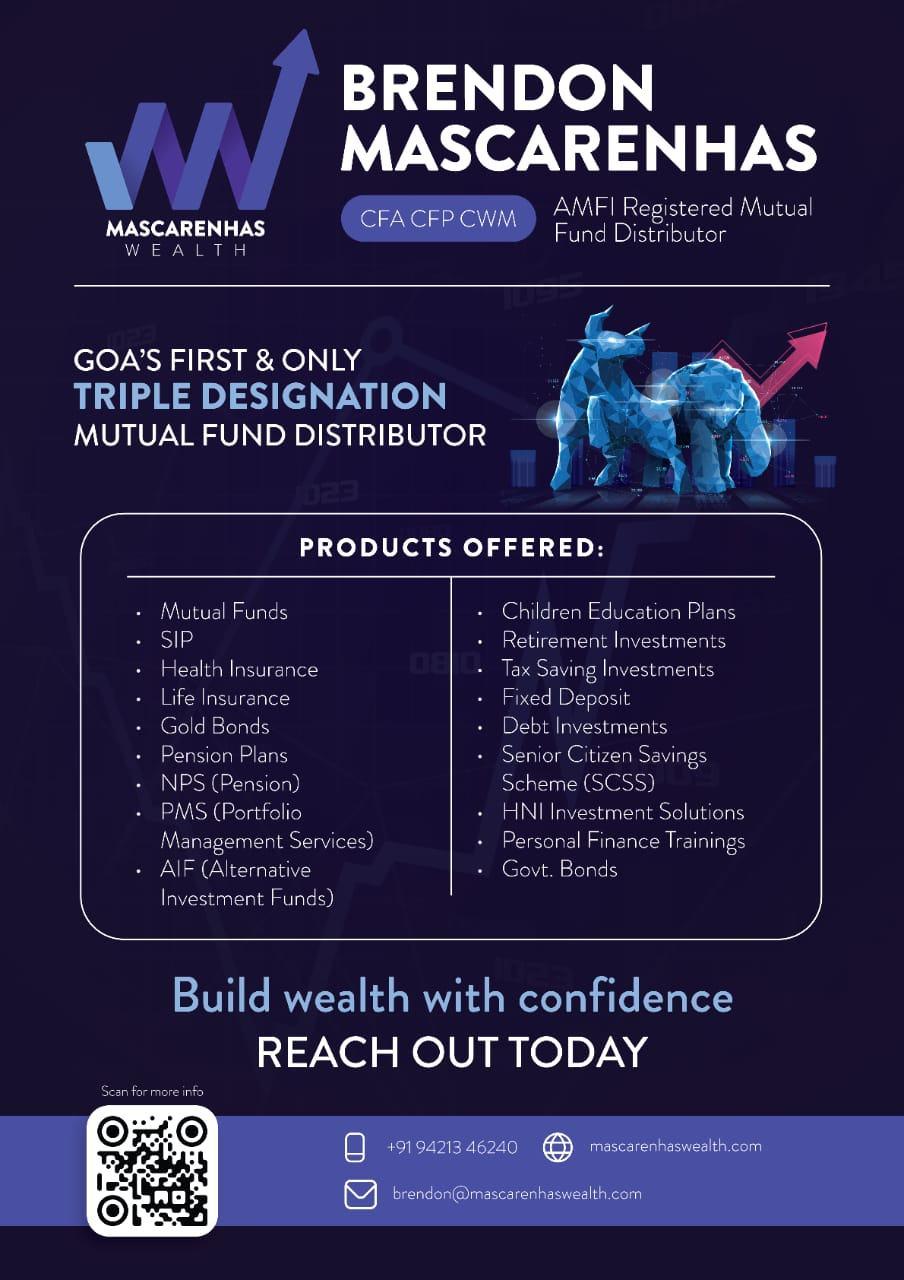

cover feature
Shaun Moses, Goa-based techno producer and DJ, blends soulful, stripped-down electronic music with global performances, authenticity, and constant evolution.
In the sun-drenched beaches of Goa, where culture and creativity collide, Shaun Moses stands as a trailblazer of the underground electronic scene. A Goa-based producer, DJ, and live act, Shaun has been at the heart of the techno movement for over a decade, shaping his sound with a unique blend of raw energy, groove, and soul. His music transcends borders, speaking a global language while remaining deeply rooted in his Goan upbringing.
Shaun describes himself simply: “I’m a Goa-based Indian producer, DJ, and live act. The genre I play and primarily produce is techno, and I’ve been at it for the last 10 years or so.” His music carries a distinct character, raw, groovy, stripped down, yet soulful, a reflection of Goa’s rich culture and its history as India’s party capital. Introduced early on to a variety of musical styles and intellectual genres, Shaun credits his home state’s eclectic sound palette for shaping his sonic identity.
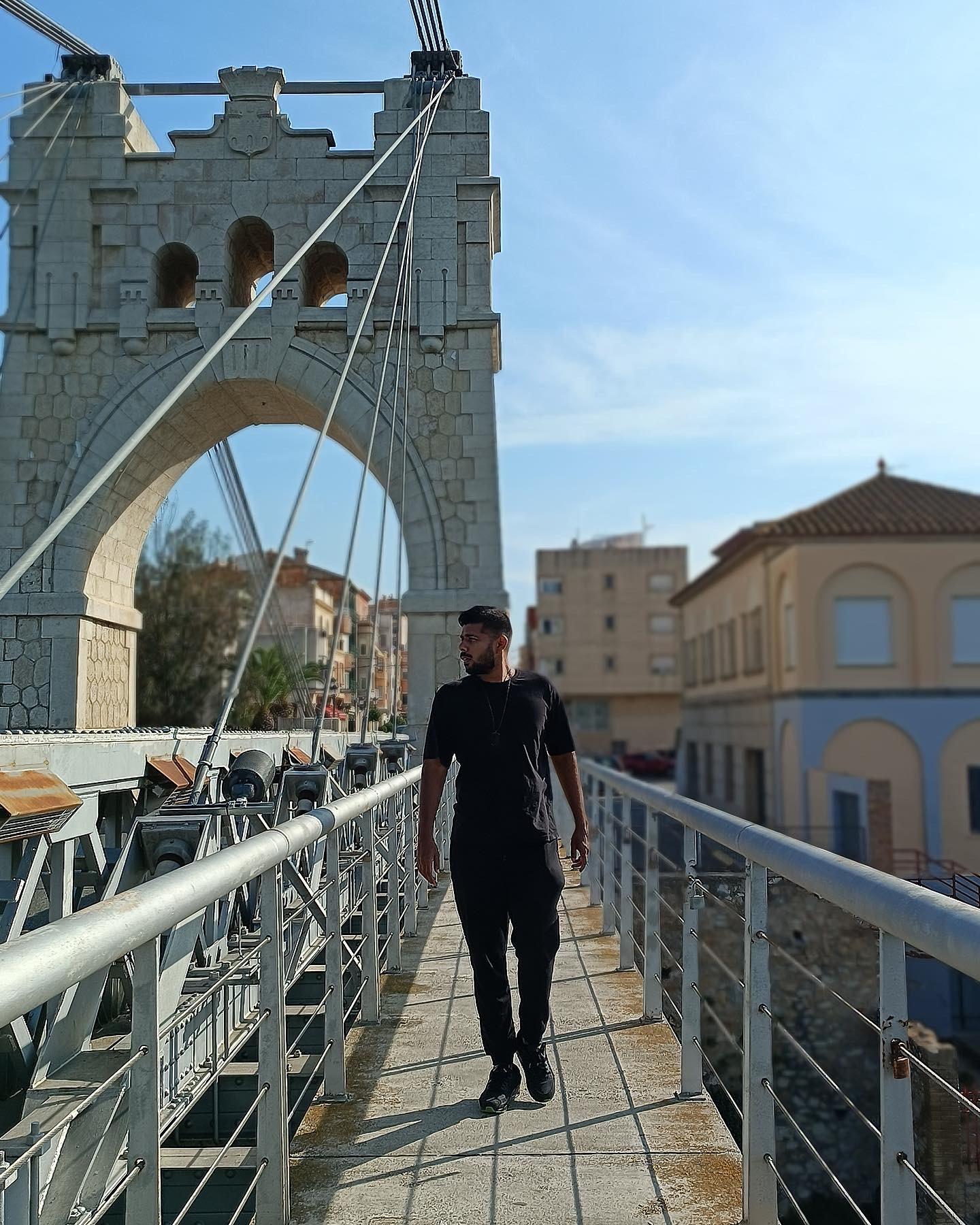
Shaun’s journey into underground electronic music was deeply personal. His father, Daniel Moses, along with his mother, Thelma Moses, founded Boutique House in 2007, a small bar at Arpora Night Market in Goa that soon became one of the most soughtafter venues. The combination of his father’s cocktail artistry and a carefully curated music lineup created a magnetic atmosphere. “I would make it almost every Saturday… assist dad where I could and hear different artists perform their signature styles.”
His defining career moment arrived in 2012, when he played his first festival, Krank in Goa, a pivotal experience. Shaun’s earliest influences include Timo Maas, Jalebee Cartel, Massive attack , Moby , Donna summer and Groove Armada, whose sounds inspired him to carve out his own identity in the electronic music landscape.
Shaun defines his signature style as: “Bouncy, fastpaced, stripped-down techno layered with soulful and euphoric grooves.” When creating new tracks, Shaun always starts with an emotion, translating personal experiences into sound. Rather than confining himself to a formula, he often draws inspiration from memorable weekends on the road or live shows. His philosophy of constant evolution is powered by experimenting with synthesisers, production techniques, travel, and collaborations with like-minded artists.
With releases on prestigious labels such as Gem Records, Molecular, Suara, and Be As One, Shaun emphasises the importance of authentic alignment: “It’s crucial to ask whether you genuinely support a label’s vision, not just for affiliation.”His performances on iconic platforms like Boiler Room and Mixmag Lab were significant milestones, amplifying his presence in the domestic and international techno scenes.

shaun moses performing at an event
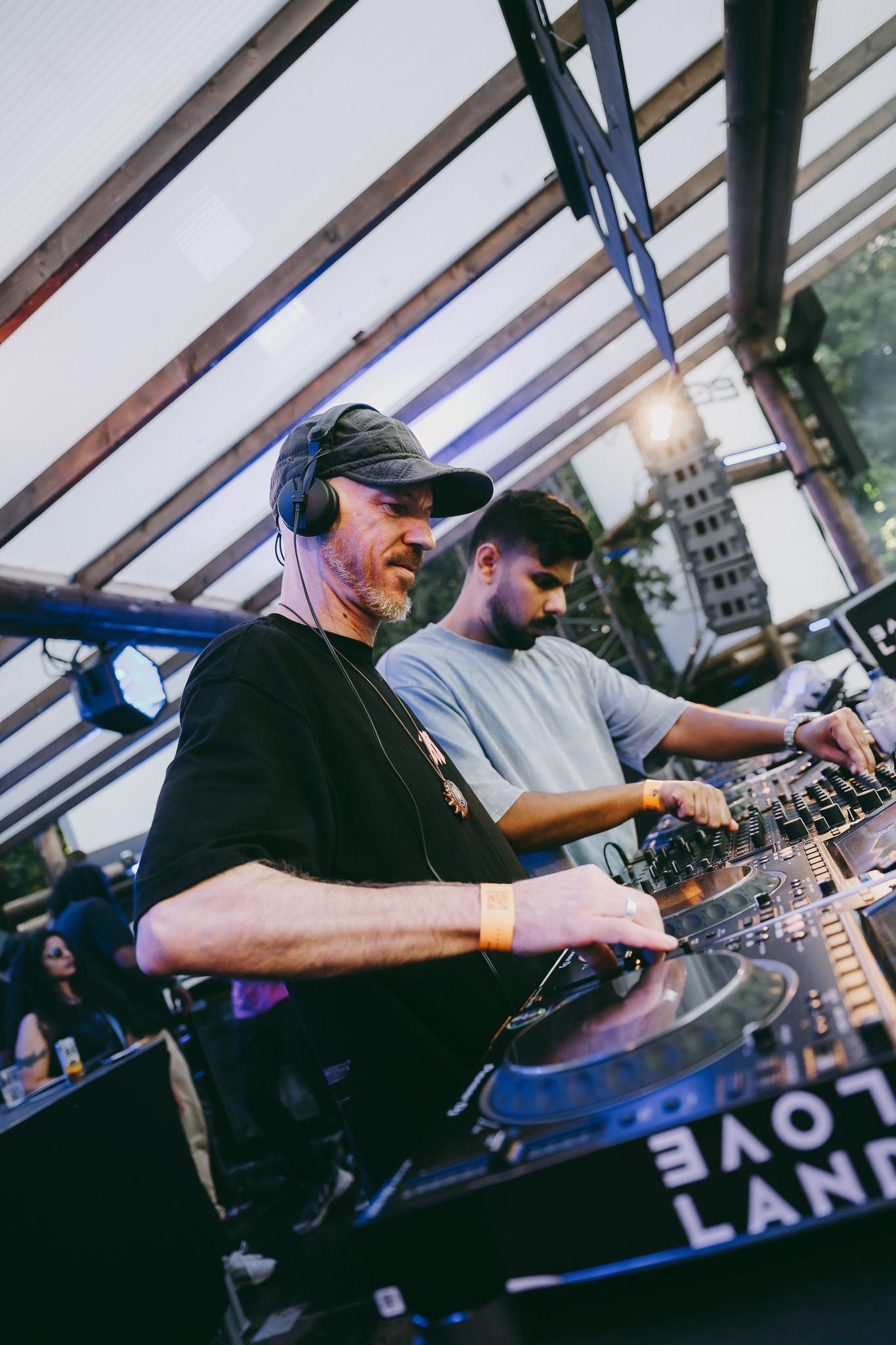
Among his most cherished gigs was a B2B set at Loveland Festival, sharing the stage with Dutch legend Secret Cinema in front of 6,000 people, a memory Shaun describes as unforgettable.
Shaun has performed across Europe, South Africa, and Russia, where he notes the passionate and dedicated crowds. “Europe has more variety in terms of audience, so I can explore different sonical directions.” Touring reshaped his production approach, helping him focus on minimalism and clarity: “Less is always more.” His journey as an Indian artist in the global techno scene hasn’t been without challenges. Visa hurdles, travel expenses, and dealing with bias added to the difficulties of carving out a global identity. Yet perseverance remained his guiding light.
Transitioning from in-the-box production, Shaun’s recent shift to analog equipment, most notably the Elektron Syntakt, has revolutionised his sound. He combines it with Ableton stock effects, Arturia, and
Roland plugins, emphasising quality over quantity. His pre-show ritual is simple but effective: “Two double espressos and 50 push-ups.”
Beyond music, Shaun works in real estate with his father and dedicates time to training at the gym, playing tennis, cooking, and baking. His disciplined lifestyle reflects the balance he maintains between creativity and routine.
Shaun believes the Indian underground techno scene has accelerated post-pandemic, citing emerging talents such as Film (Sanil Sudan), Jay Pei, Audio Units (Ashwin & Ashrith Baburao), and 8-bit Culprit (Faraz Ehsan). Collectives like Maushi (Pune), Void (Jaipur), Sound Simplify (Hyderabad), Forward and Afterworx are also making waves.
“We need lesser reliance on international headliners and better budgets for homegrown artists at major shows.”
Looking ahead, Shaun is set to release tracks on Paul Ritch’s Quartz Recordings and Marco Lenzi’s Molecular Recordings later this year. His dream collaborations include working with Ray Kajioka and Steve Rachmad, as well as playing at iconic festivals like 909 and Stone Techno Festival. “There will be a constant evolution every year, and I leave it to my followers to decide whether they like it or not.”
At the core of Shaun’s journey lies one principle: authenticity. His advice to aspiring producers is clear: “Don’t do it for fame or the limelight, you’ll burn out quicker than you think.”
For Shaun Moses, success is not measured by commercial achievements but by the profound satisfaction of hearing his tracks played by the best artists on the biggest stages, and having audiences instantly recognise his distinct sound. www.itsgoa.com
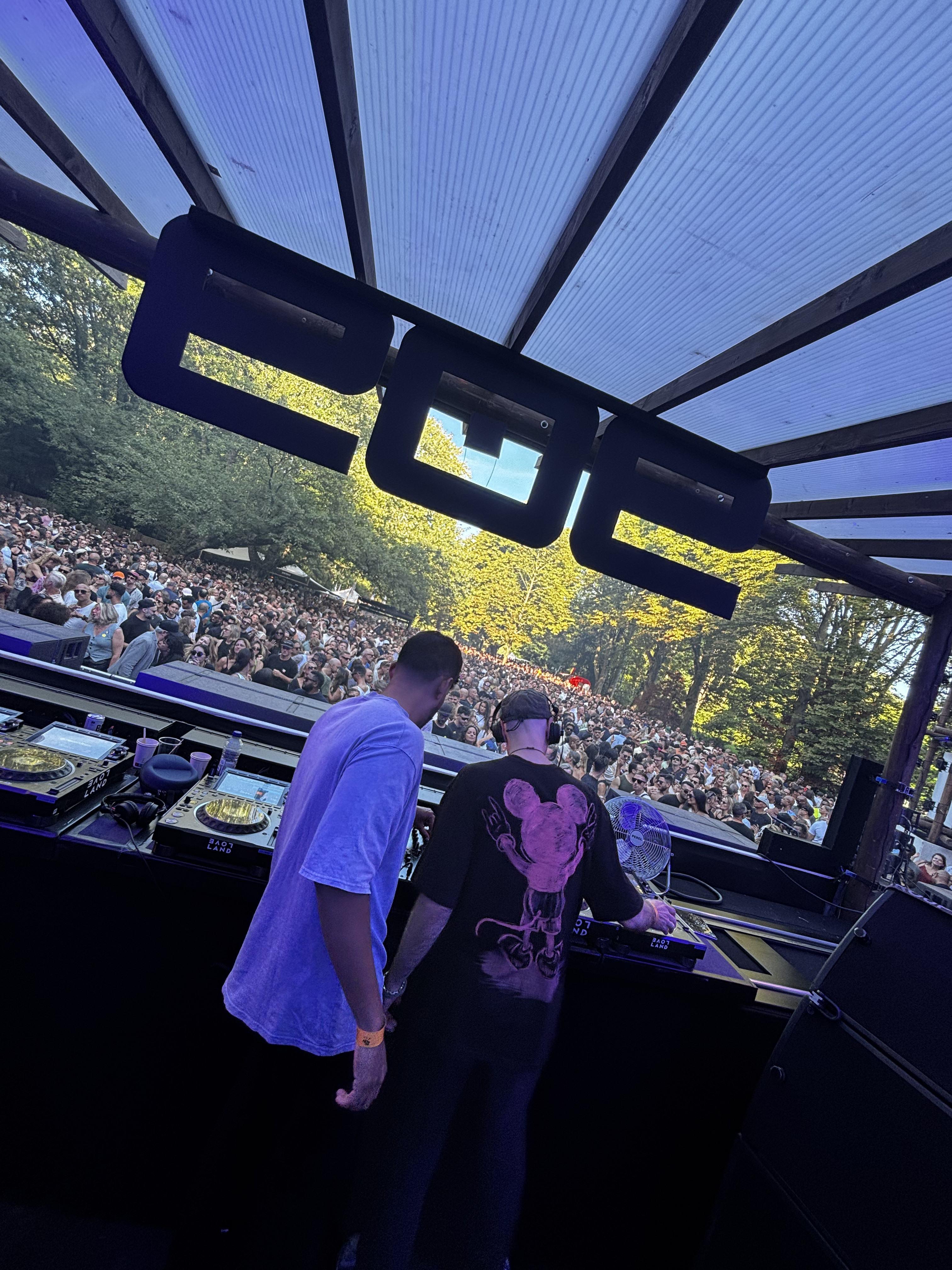
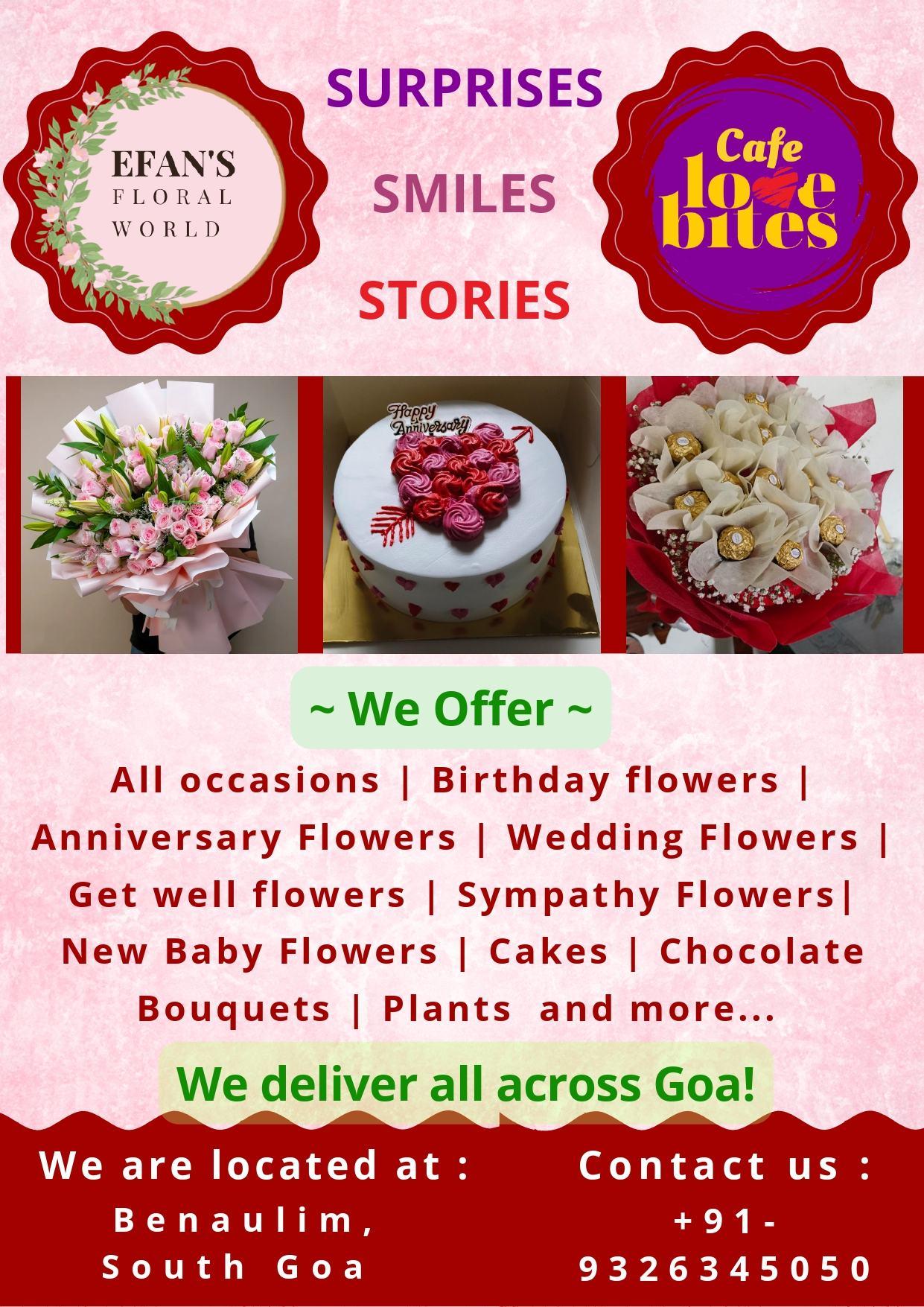
Desmond Fernandes, Goan creator of Dez Horror Stories, turns real-life experiences and local legends into immersive horror content, blending storytelling, emotion, and persistence to redefine India’s paranormal narrative.
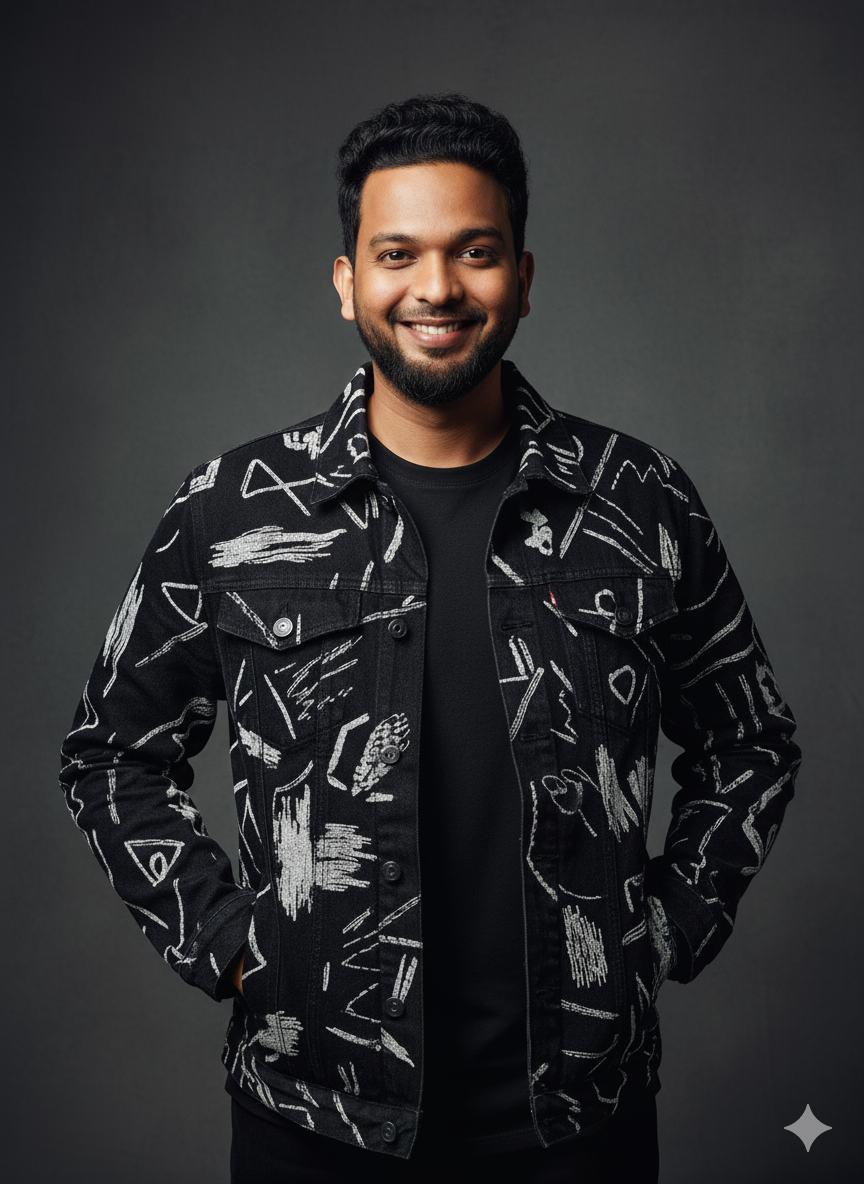
www.itsgoa.com itsgoa_ Itsgoa
Hailing from Goa, Desmond Fernandes is a content creator who has transformed his fascination with the paranormal into a thriving digital presence. While his love for storytelling existed for years, it wasn’t until 2020 that he ventured into content creation on YouTube and Instagram. Despite three years of effort that “just didn’t work out,” Desmond didn’t give up. In May 2024, he launched Dez Horror Stories, a platform dedicated to chilling narratives inspired by real-life experiences, urban legends, and the unexplained.
Desmond sees himself primarily as a storyteller. Growing up in Goa, evenings were often spent sharing ghost stories with cousins and listening to his grandmother’s eerie tales. It wasn’t until a personal experience pushed him toward the paranormal that he began to take storytelling seriously.
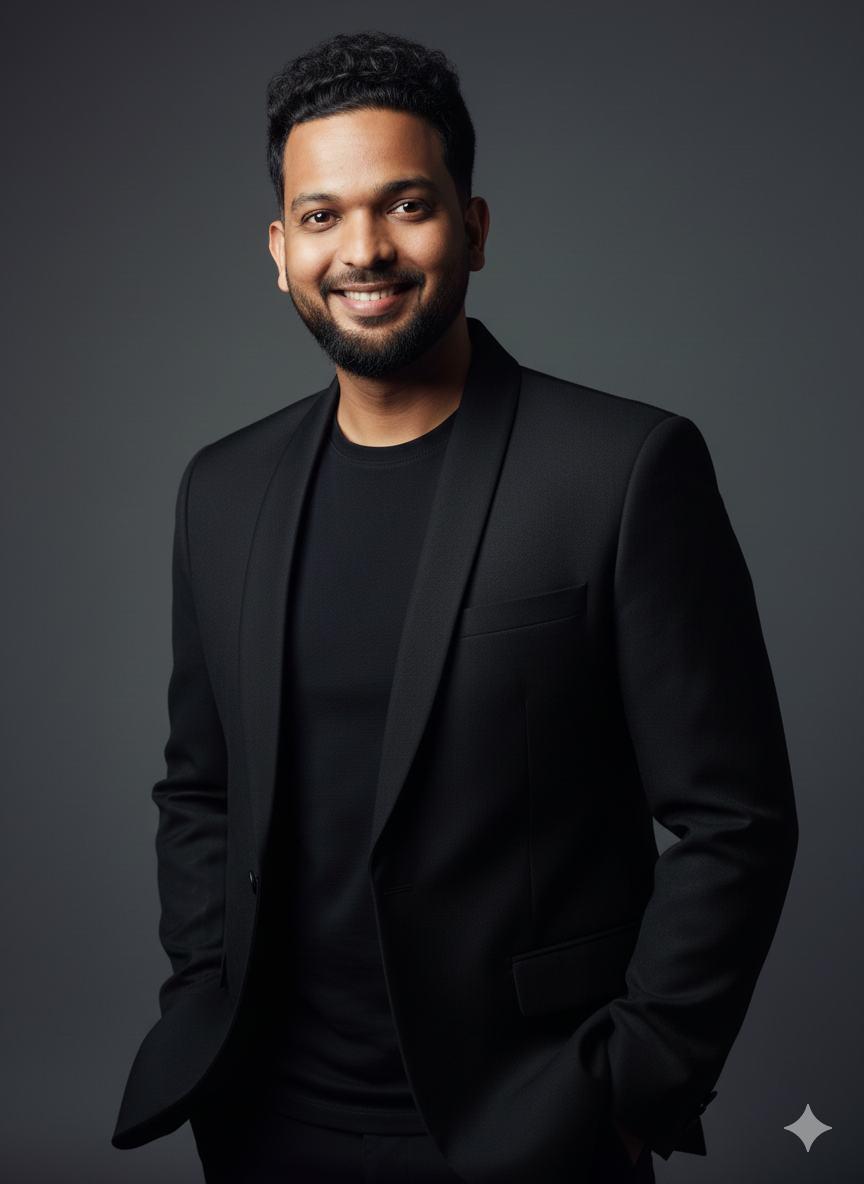
Today, his content blends entertainment, suspense, and investigation, offering audiences a taste of fear through a deeply personal lens.
The majority of Desmond’s stories are narrated short videos inspired by followers’ experiences. Each story is carefully researched to ensure authenticity and structured for maximum suspense.
While he doesn’t claim that any story is completely true, his goal is to translate these experiences into compelling narratives that give viewers chills, all while maintaining entertainment and respect for the original storyteller.
Without formal training in art or production, Desmond has learned through observation and experimentation. He meticulously balances visuals, sound, and narration to create immersive horror experiences. With every story, he refines his skills, enjoying the process of bringing suspense and fear to life.
Desmond’s audience primarily consists of horror fans who appreciate the craft behind his work. Social media reactions vary, but he focuses on feedback that helps him improve. Comments, messages, and reactions from followers are invaluable in shaping his future content, ensuring that every story resonates with the community he has built.
Balancing his content creation with a full-time job is one of Desmond’s main challenges. He dedicates at least an hour each day to Dez Horror Stories, focusing on consistency and quality.
Handling both praise and criticism has taught him to concentrate on support and let negativity slide, allowing his passion to remain the driving force behind his work.
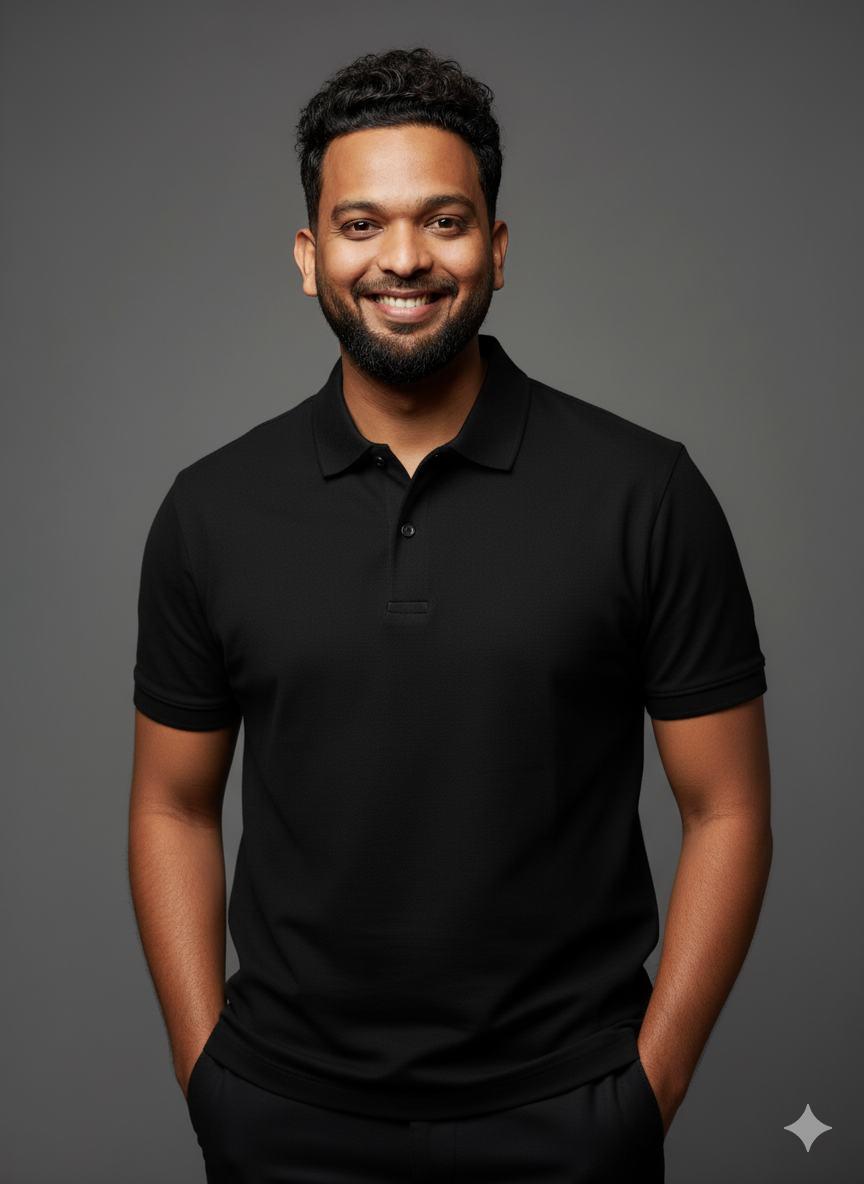
One of the most rewarding experiences for Desmond came recently at Mapusa market. People recognised him, offering positive feedback that brought immense pride to his mother.
For Desmond, moments like these affirm the value of his creative journey and demonstrate that his work is appreciated not just for entertainment, but as a true art form.
Desmond also harbours a personal story from his life that has influenced his work, shared only with close friends and family.
He plans to reveal this story on Dez Horror Stories, promising followers an intimate glimpse into his own paranormal experiences.
What sets Dez Horror Stories apart is its focus on local Goan tales, urban legends, and first-hand accounts that are rarely shared online.
Desmond emphasises that storytelling has no competition—every story deserves to be told, and each creator contributes uniquely to the genre.
While initially content with creating for passion alone, Desmond is now exploring brand collaborations and professional opportunities.
He is seeking a manager to handle partnerships and help him expand Dez Horror Stories into a recognised brand in the horror niche.
Desmond believes that horror in India remains largely untapped. For him, it isn’t merely a genre—it’s storytelling in its most visceral form. Love, drama, fear—they all blend into the art of creating compelling content that captivates audiences.
For those looking to enter the horror or podcast space, Desmond advises: embrace criticism, use doubters as motivation, and remain consistent. Whether success comes or not, people will talk—but staying committed and believing in your craft is what truly matters.
Desmond Fernandes continues to push the boundaries of horror content creation in India, merging Goan folklore, real-life experiences, and narrative skill to deliver chilling yet captivating stories. His journey proves that persistence, creativity, and a passion for storytelling can turn fascination into a platform that resonates with thousands.
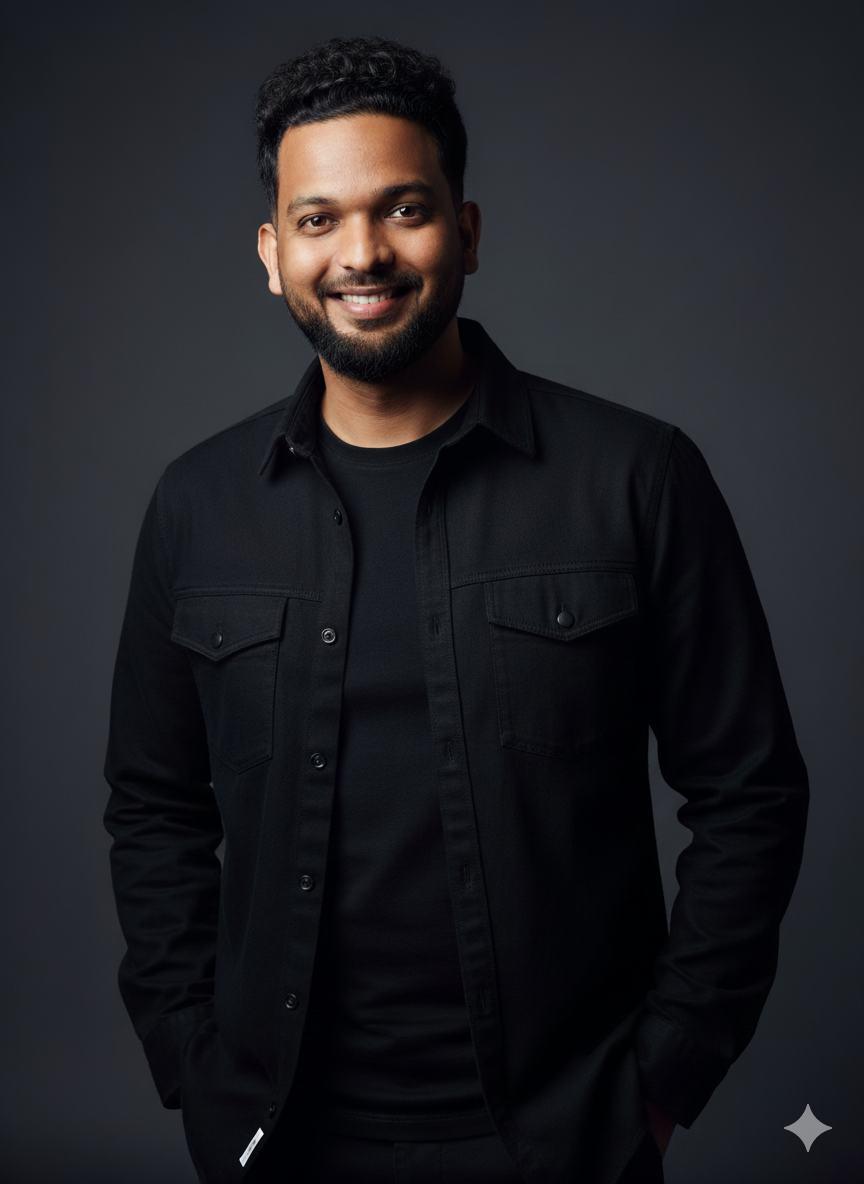

Sachi Kurtarkar Kamat, a self-taught Goan artist, transforms emotions into expressive, layered artworks— blending intuition, colour, and texture to create deeply personal, evolving visual stories.
Sachi Kurtarkar Kamat, a self-taught artist based in Goa, has transformed her passion for art into a medium of connection, expression, and storytelling. For Sachi, painting is not merely a creative pursuit — it is a way to capture emotions, explore inner landscapes, and communicate experiences that words often fail to convey. Her work is constantly evolving, driven by curiosity, experimentation, and a desire to challenge herself with new ideas and techniques.
Sachi’s artistic path began without formal training. She started with simple sketches as a means of expressing her emotions, gradually discovering a deeper pull toward painting on canvas.
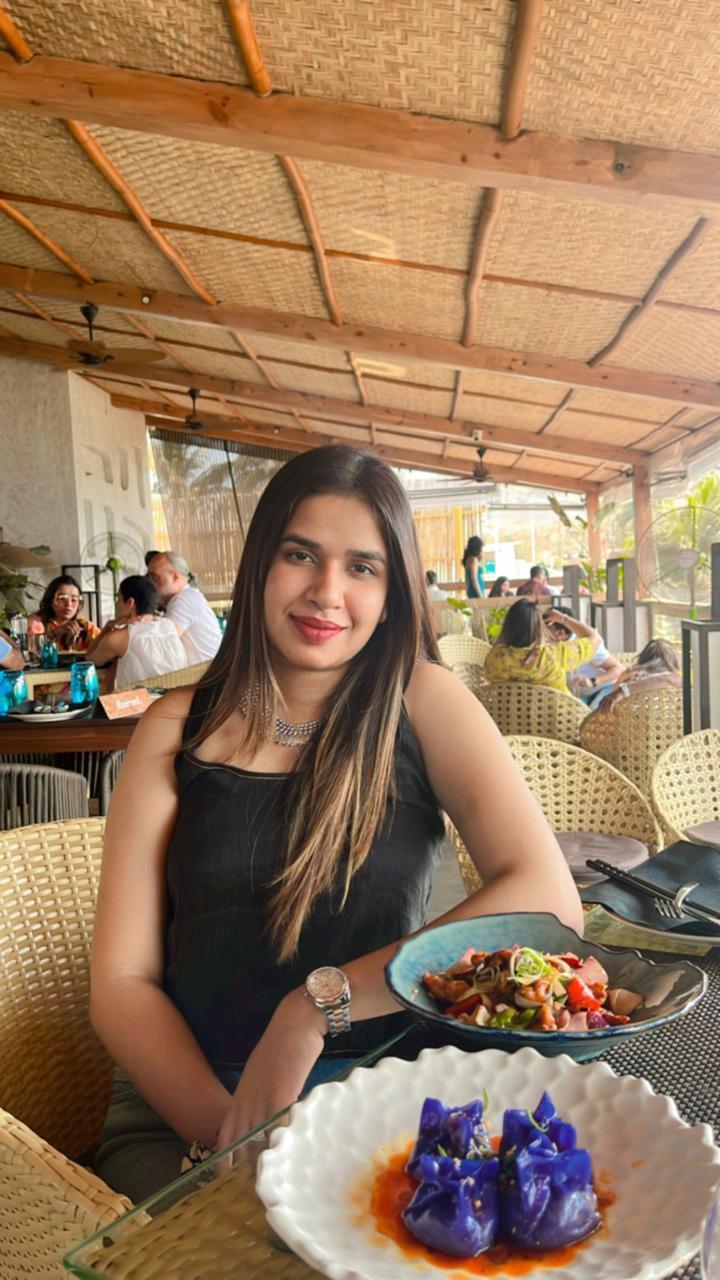
The first encounter with a blank canvas was transformative, offering her a space to reflect, feel, and narrate stories that had no words. Canvas became a playground for bold, messy, raw, and soft expressions all at once. What initially began as a personal escape evolved into a professional journey rooted in self-expression and authenticity.
Her artistic style is emotional and evolving, blending contrasts of softness and boldness that reflect the mood behind each piece. Sachi’s work defies rigid categorisation, instead focusing on feelings such as peace, chaos, or joy, which she translates into texture, colour, and spatial composition.
Nature, human connections, and everyday moments form recurring themes, often symbolising grounding, growth, and freedom. Among the artists and movements that have inspired her, Sachi highlights Zao Wou-Ki, Piet Mondrian, and Mark Rothko, whose works shaped her understanding of colour, abstraction, and emotional resonance.
Sachi’s process begins intuitively, rarely with a fixed concept. It can start from a colour that draws her, a mood, or a fleeting impression from nature.
Sometimes it is completely spontaneous — a need to pour internal feelings onto the canvas without knowing the exact outcome. Once an idea emerges, she allows it to settle, selecting a palette that matches the emotion: warm tones for grounding, cool for calmness, and bold for intensity.
Painting is a layered process for her. Initial layers are loose and experimental, forming a dynamic base, followed by added texture, contrast, and refinement.
She often steps back multiple times to observe the evolution of the piece, allowing it to guide her rather than forcing it to fit an original vision. This approach fosters authenticity and emotional resonance in every artwork.
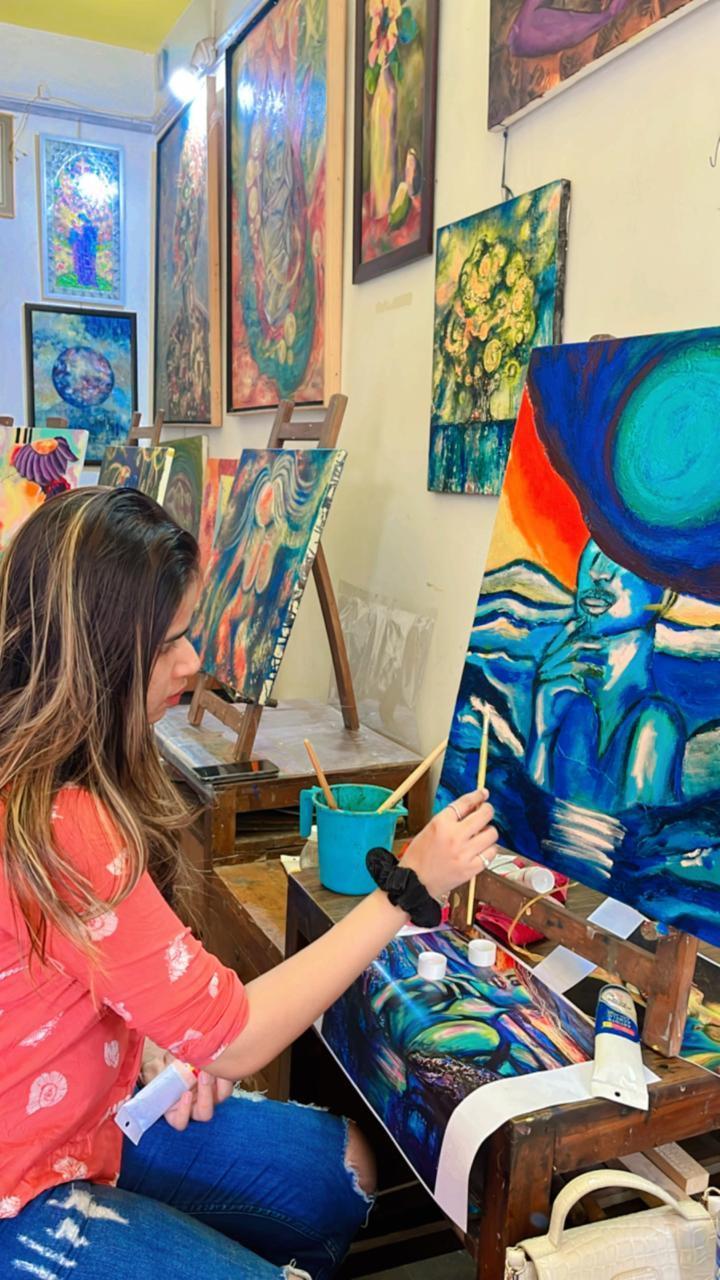
Sachi at work on her expressive canvas
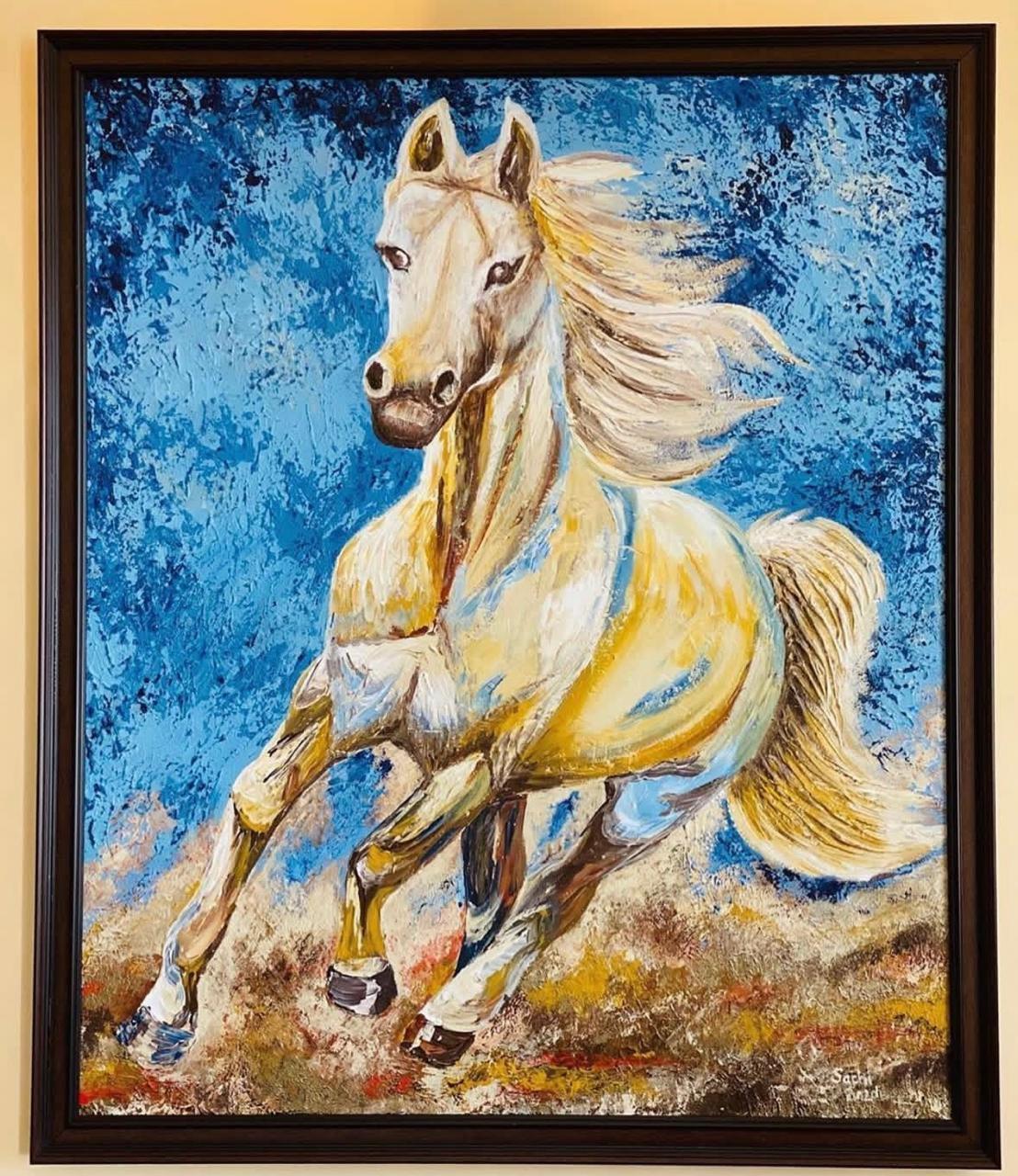
Sachi’s work reflects her internal landscape, even when she doesn’t fully understand it initially. Growing up in Goa, she feels a deep connection with nature, which frequently appears in her paintings — oceans, skies, flowers, and organic forms often symbolise grounding, growth, and freedom. Colour plays a pivotal role, functioning as an emotional language. Muted tones offer calmness, bright hues convey intensity or uplift, and the interplay of shades creates movement or silence, telling a story through feeling rather than mere aesthetics.
Like any artist, Sachi has faced challenges in her work. One particular piece tested her both technically and emotionally. Initially guided by a fixed idea, she found the colours clashing and the composition forced, leading her to consider abandoning the painting. Instead, she allowed herself breaks, revisited the canvas with fresh perspective, and gradually refined it, peeling away layers and softening elements. This experience reinforced her belief in patience, adaptability, and letting art evolve organically.
Sachi primarily works with acrylics on canvas for their versatility and fast-drying properties, allowing her to build layers and textures intuitively. She uses brushes, palette knives, and sometimes her hands to apply paint, depending on the energy she wishes to convey.
Over time, her techniques have embraced imperfection and fluidity, incorporating mixed media such as charcoal, soft pastels, and textured gels to add depth and richness. This evolution reflects her growth as an artist, shifting from precision and control to embracing spontaneity and emotion.
During creative blocks, Sachi slows down rather than forcing output. She draws inspiration from nature, music, journaling, and presence in daily life, recognising that art can emerge from observation and feeling as much as from active creation. Reconnecting with her original intention — to express and process emotions — remains her primary source of motivation.
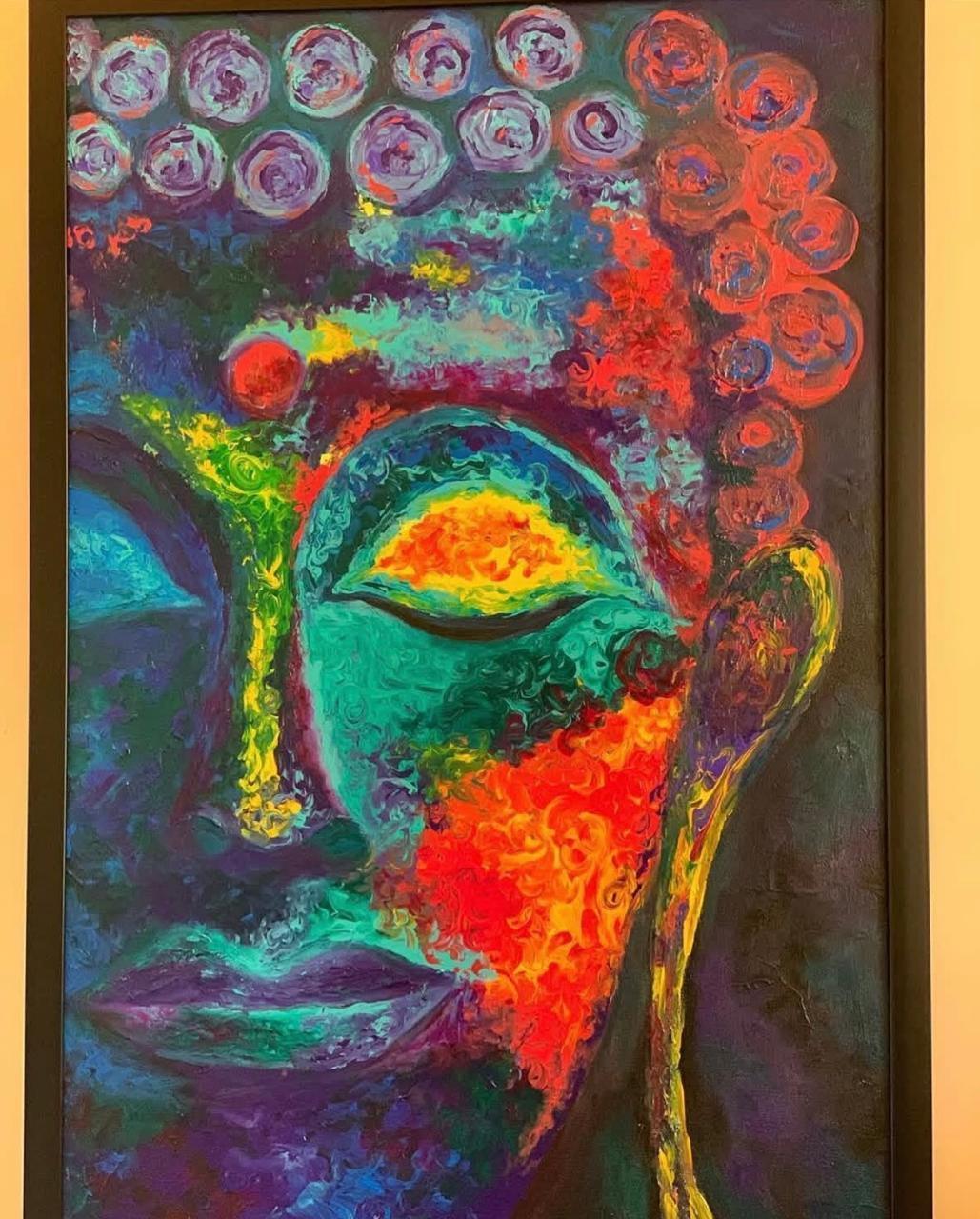
Beyond creation, Sachi has learned to approach the business side of art thoughtfully. Social media, particularly Instagram, allows her to share both finished pieces and glimpses of her process, connecting with a broader audience. She participates selectively in exhibitions, group shows, and pop-ups that align with her artistic voice, providing opportunities to grow her presence, collaborate with fellow artists, and engage with collectors who appreciate her work.
One of her recent pieces holds a special place in her heart, capturing a period of emotional overwhelm through intuitive layering of soft and bold brushstrokes. The painting became a visual journal, conveying the coexistence of strength and vulnerability. For Sachi, such works reaffirm the power of art to process complex emotions and celebrate the human capacity to feel multiple truths simultaneously.
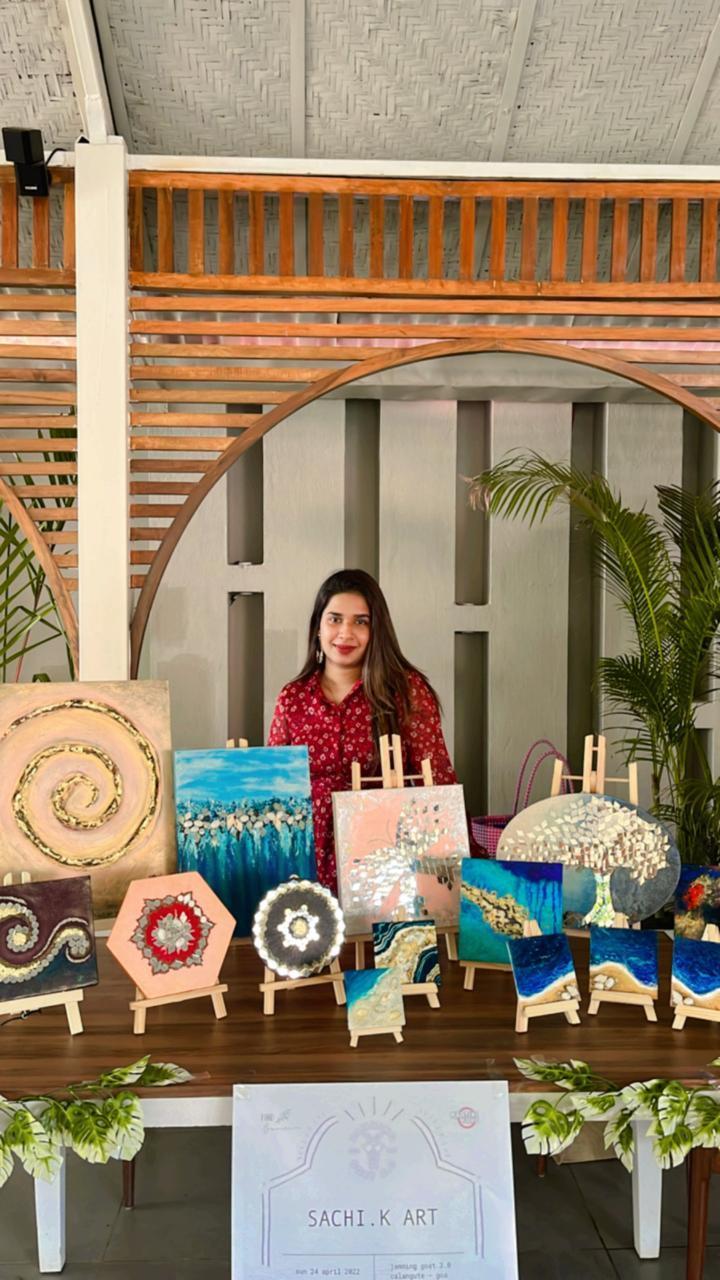
pieces evolve naturally. Art is personal; growth varies
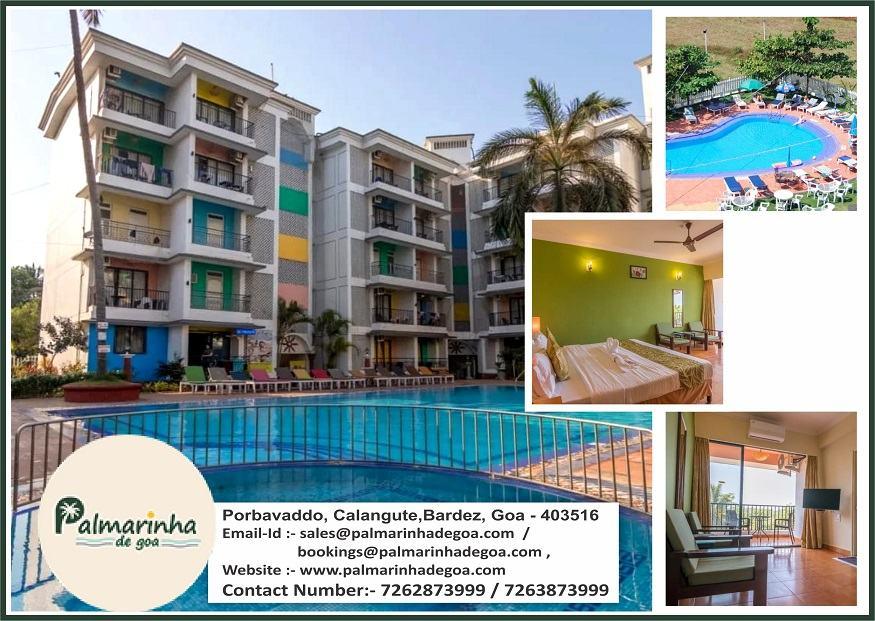

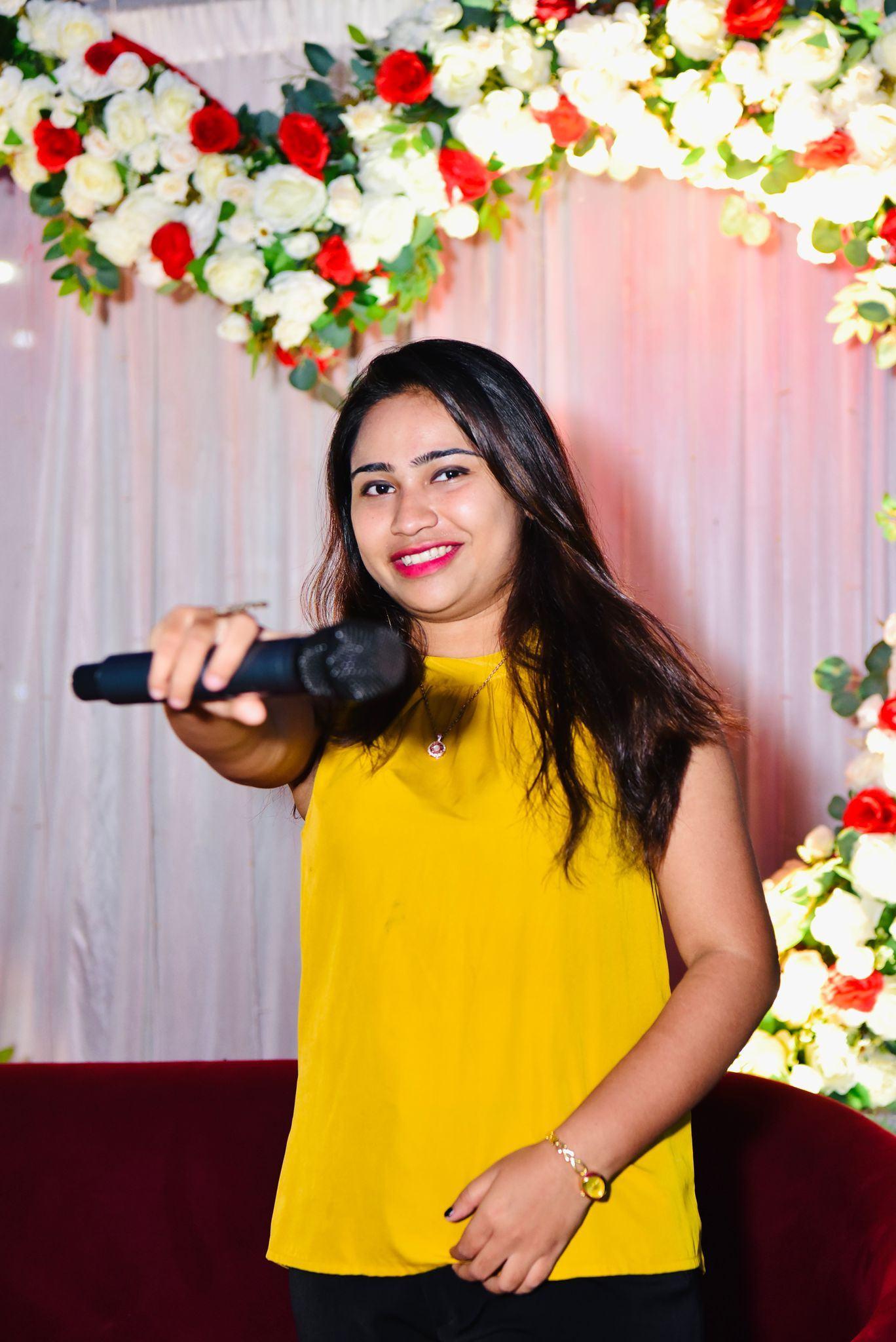
Hensika Fernandes, a dynamic Goan emcee, blends confidence, adaptability, and storytelling to create seamless, high-energy, and engaging event experiences.
Hailing from South Goa, Hensika Fernandes is more than just a master of ceremonies—she is a storyteller, energy manager, and voice of assurance on stage. A graduate with teacher training from the Nirmala Institute of Education, her journey into emceeing began at the age of 21.
What started with school events and small family gatherings soon evolved into a professional career where her natural confidence, voice control, and audience engagement set her apart.
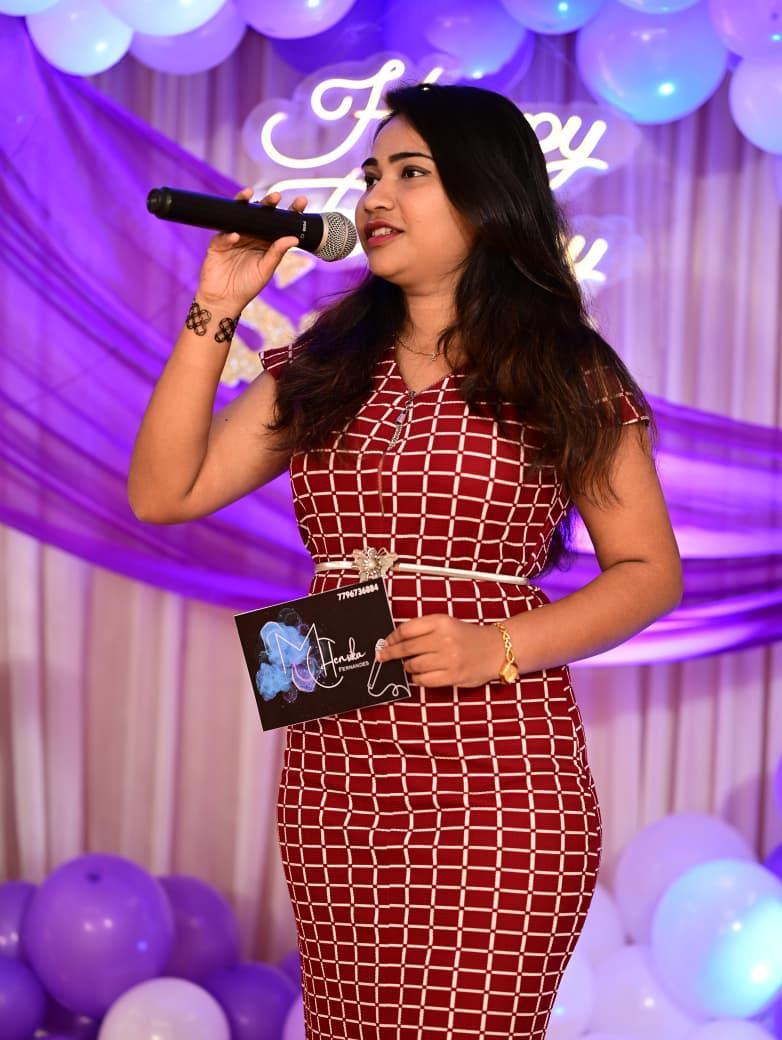
Hensika vividly recalls her first professional event in October 2024. A mix of happiness and nerves filled that moment, but as soon as she took the mic, she knew this was where she belonged. The thrill of holding the audience’s attention and ensuring a seamless experience became her greatest motivation to pursue hosting professionally.
When asked to describe her hosting style in three words, Hensika chooses: Seamless, Adaptive, Insightful. She thrives in live, interactive events— where spontaneity can often be unpredictable.
Guiding those moments into coherent, engaging conversations is where her strength lies. Her goal is always the same: to deliver a smooth, high-energy experience that resonates with the audience.
Preparation is key for Hensika. Before every event, she carefully reviews timelines and speaker names to ensure precision.
She takes a few deep breaths, stretches, and mentally walks through possible challenges. For her, it’s not just about calming nerves—it’s about channeling energy into confidence.
Crowds can be tough, but Hensika doesn’t fight their energy. Instead, she acknowledges the mood, finds one point of connection, and builds from there. With humour—often light and self-deprecating—she effortlessly smooths transitions during unexpected hiccups.
While she hasn’t faced a major on-stage disaster yet, her calm, adaptable approach ensures she’s always ready.
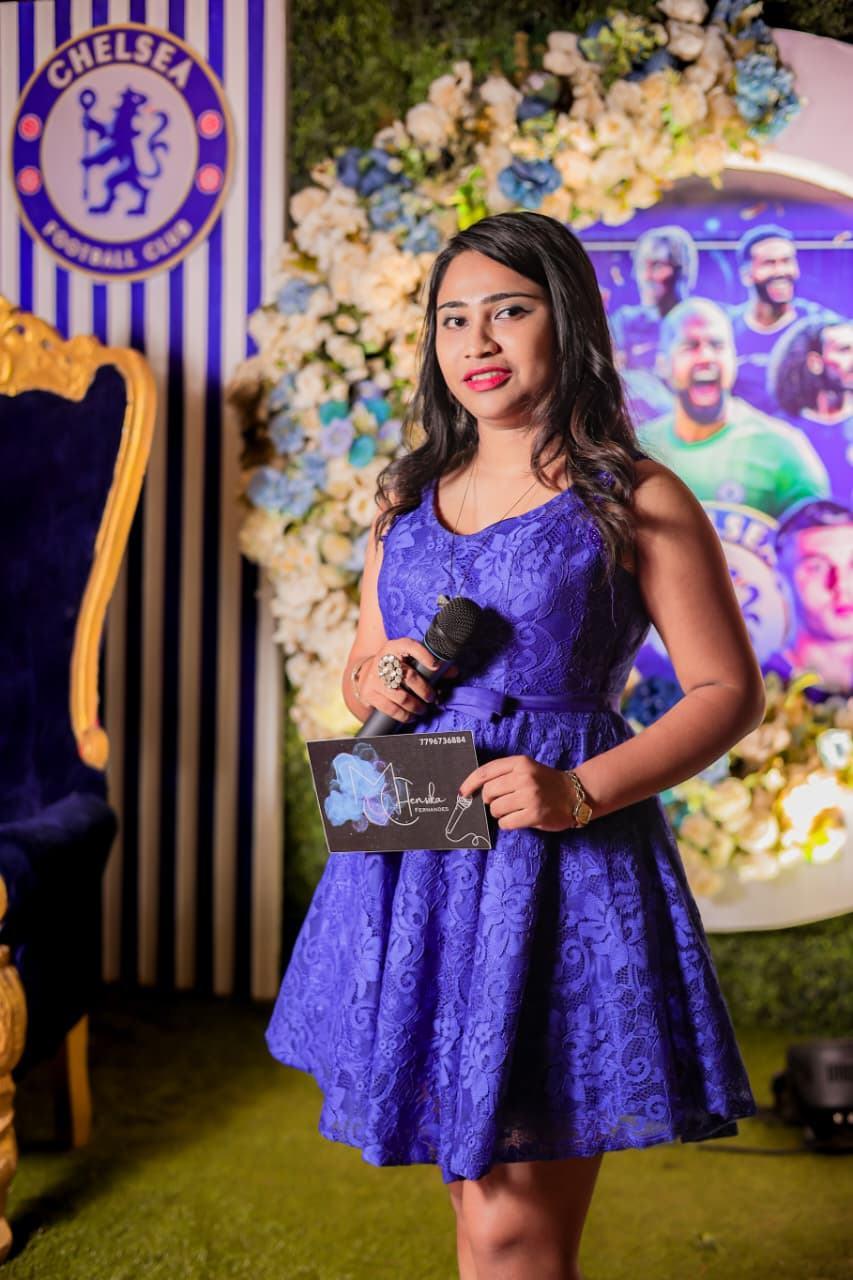
Hensika in her elements
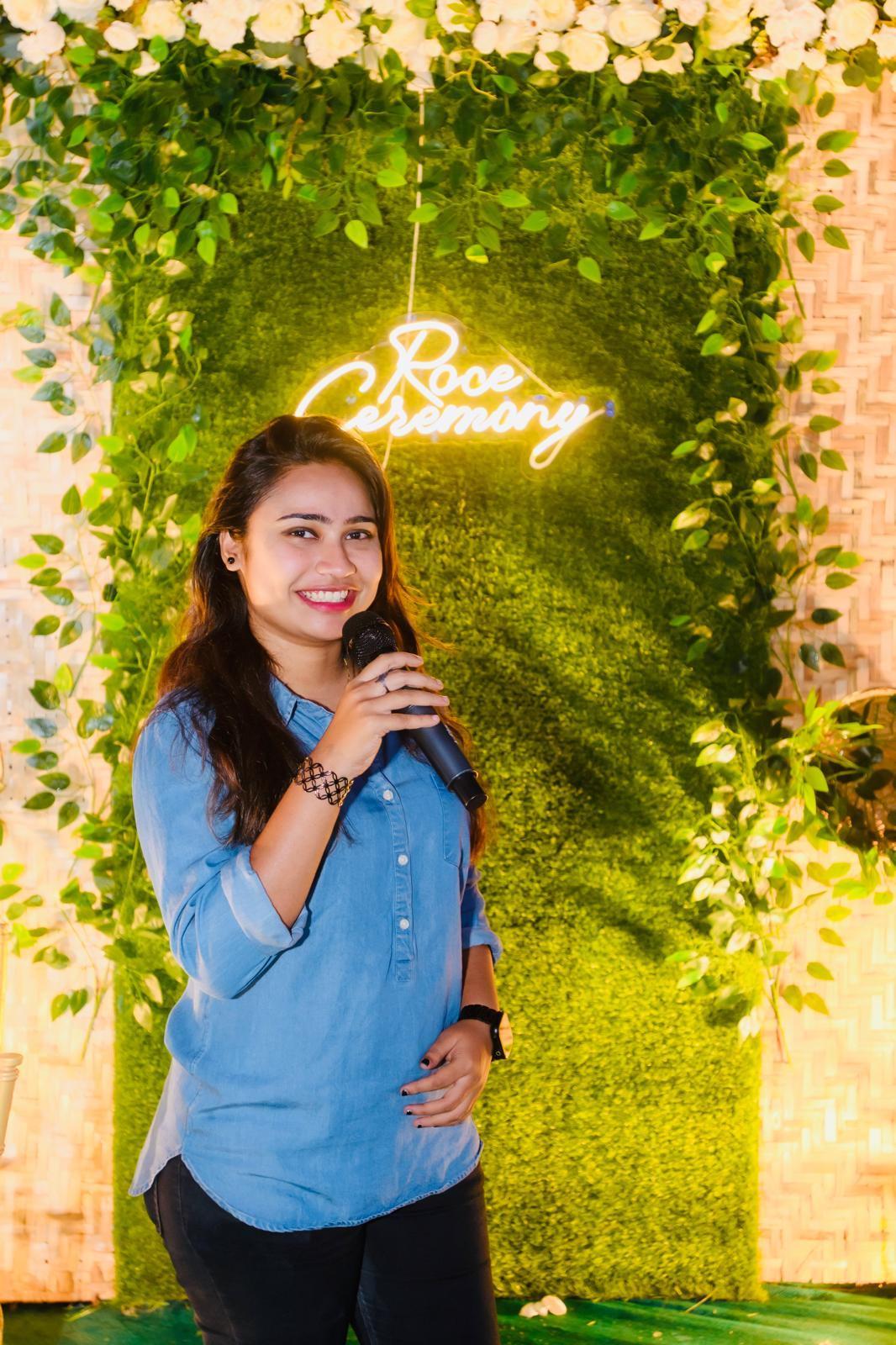
For Hensika, no single event stands above the rest. Each one carries its own significance, and every audience adds to her journey as a host. To sustain her energy, she follows a disciplined routine: six to eight hours of rest, warm water or tea for hydration, vocal warm-ups, and quick breathing exercises during breaks. These practices keep her voice and presence sharp.
Her hosting process is a balance of structure and improvisation. She scripts only what’s essential— names, titles, sponsor mentions—while leaving the rest in flexible bullet points. She also prepares for delays with what she calls a “Flow Audit,” along with filler content like quick polls, trivia, or jokes to keep audiences engaged.
For Hensika, an emcee isn’t the star of the show. “We are the Chief Energy Manager and Emotional Architect,” she explains. Her role is to listen, connect, and keep the flow invisible yet seamless.
This philosophy has shaped her into a calmer, more resilient individual off-stage, making everyday stress feel minor in comparison to handling live events.
Beyond her work, Hensika inspires aspiring MCs to build self-trust. Her mantra—“Trust Your Prep, Then Trust Your Gut”—teaches the importance of preparation balanced with instinct. She also emphasises the power of pauses, knowing that silence at the right moment can speak louder than words.
Before stepping on stage, her go-to hype song is “Don’t Stop Me Now”, and she swears by the Dynatech G2 series cordless mic for its reliability. People often describe her in one word: Anchored—a fitting reflection of her grounded yet dynamic presence on stage.
Her advice is simple yet powerful:
The event is about the audience, not you. If you make a mistake, don’t dwell—smile, move on, and the audience will follow.
Prepare not just for your opening, but also for the natural dips in energy, like post-lunch sessions, with your best interactive material.
In every event she hosts, Hensika Fernandes brings a sense of assurance, rhythm, and connection that makes audiences feel seen and engaged. For those looking to elevate their events with a voice that is confident, adaptable, and truly anchored, Hensika remains just a call or message away.
Goa’s first female pilot with FLY91, Captain Keziah Fernandes, turned her childhood dream into reality — from Cuncolim to the cockpit, inspiring Goan women to chase ambitious skies. Article & Images by: Team ItsGoa

itsgoa_ Itsgoa
~ According to Keziah, Goa's first pilot to take to the air with FLY91, her inspiration is her brother, also a pilot.
~ She became a certified pilot at 19 and a certified instructor at just 20 years of age!
Growing up in Goa, Keziah Fernandes often heard how people from the state were referred to as too laid back to chase ambitious careers.
The peaceful pace of life, the strong sense of community and the comfort of home were constants in her upbringing. But somewhere along the way, the idea took hold that if she wanted to aim higher -- in her specific case, quite literally too -- she would need to leave Goa behind.
"There’s a common perception that people from Goa tend to lead a more laid-back life, which often made me feel that to pursue something ambitious, I’d need to move out of the state," she said.
Today, Keziah (26) is Goa’s first woman pilot flying for FLY91, a pure play regional airline based in her home state, something she once thought would never be possible.
Born in Margao and originally from Cuncolim, Keziah studied at King’s School in Margao and completed her higher secondary at Don Bosco, Panaji. Her interest in aviation began at home. “My initial inspiration came from my brother, who is a pilot himself. Seeing his life; the pictures he would send from the cockpit and the stories he shared, really drew me to that lifestyle.”
Keziah was 16 when she stumbled on a story in a magazine that added fuel to the idea. “Around the same time, I came across a magazine story about an 18-year-old who became the youngest pilot in India... That story really motivated me. I was 16 then and thought, ‘If she can do it, I can too.’”
Keziah began her training journey at 17 in the United States. “After my 12th standard, I initially stayed in Delhi for a short period before moving to the US. I was optimistic that I’d become a pilot
quickly, perhaps by the age of 18. However, delays meant I obtained my commercial licence at 19.”
Rather than return immediately to India, she chose a less common route. “I was fortunate to receive strong guidance from my instructors, who encouraged me to become a flight instructor... I became a certified instructor at 20. I was the only female pilot in my school at the time, which brought its own set of challenges, both in terms of gender and age.”
Eventually, she decided to return home. “I missed home and didn’t want to settle abroad. One day, I simply packed my bags and came back to India. That’s when I discovered FLY91... it felt like the perfect match.”
Flying with FLY91 marked a turning point. “It was a magical experience, one filled with excitement, nerves and immense pride... Representing Goa on a Goan airline felt surreal.” FLY91, which launched its services last year, is committed to connecting underserved destinations like Goa; Maharashtra's Sindhudurg, Jalgaon, Solapur and Pune regions; Agatti in the Lakshadweep islands, Hyderabad and Bengaluru.
Her first sector was Pune–Sindhudurg-Goa. “I had never visited Sindhudurg before, despite its proximity to Goa, but I found it to be a beautiful and promising location.”
She’s also experienced gender bias in the cockpit. “Even today, passengers are often surprised to see a woman in the cockpit... I often felt I had to work harder to prove myself, not just as a woman, but as someone young and physically smaller.”
But confidence, she says, goes a long way. “I started projecting confidence, even when I didn’t feel it— and eventually it became real.”
To young girls in Goa dreaming of aviation, her advice is measured and clear: “Do your research, reach out to flight schools, talk to people in the industry and ask questions... Being a girl from Goa is not a limitation. In fact, it’s a strength and part of a journey you should be proud of.”
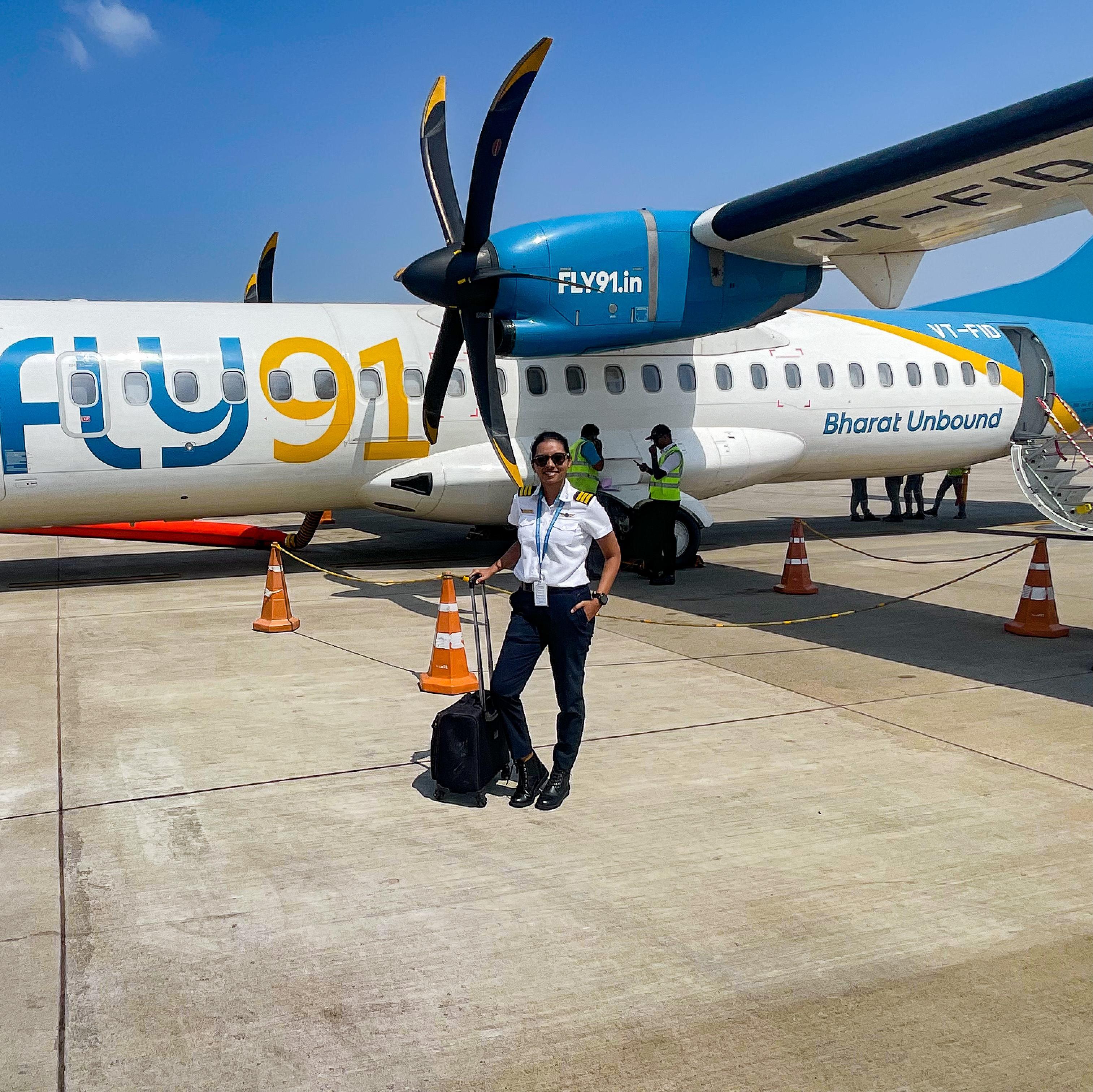
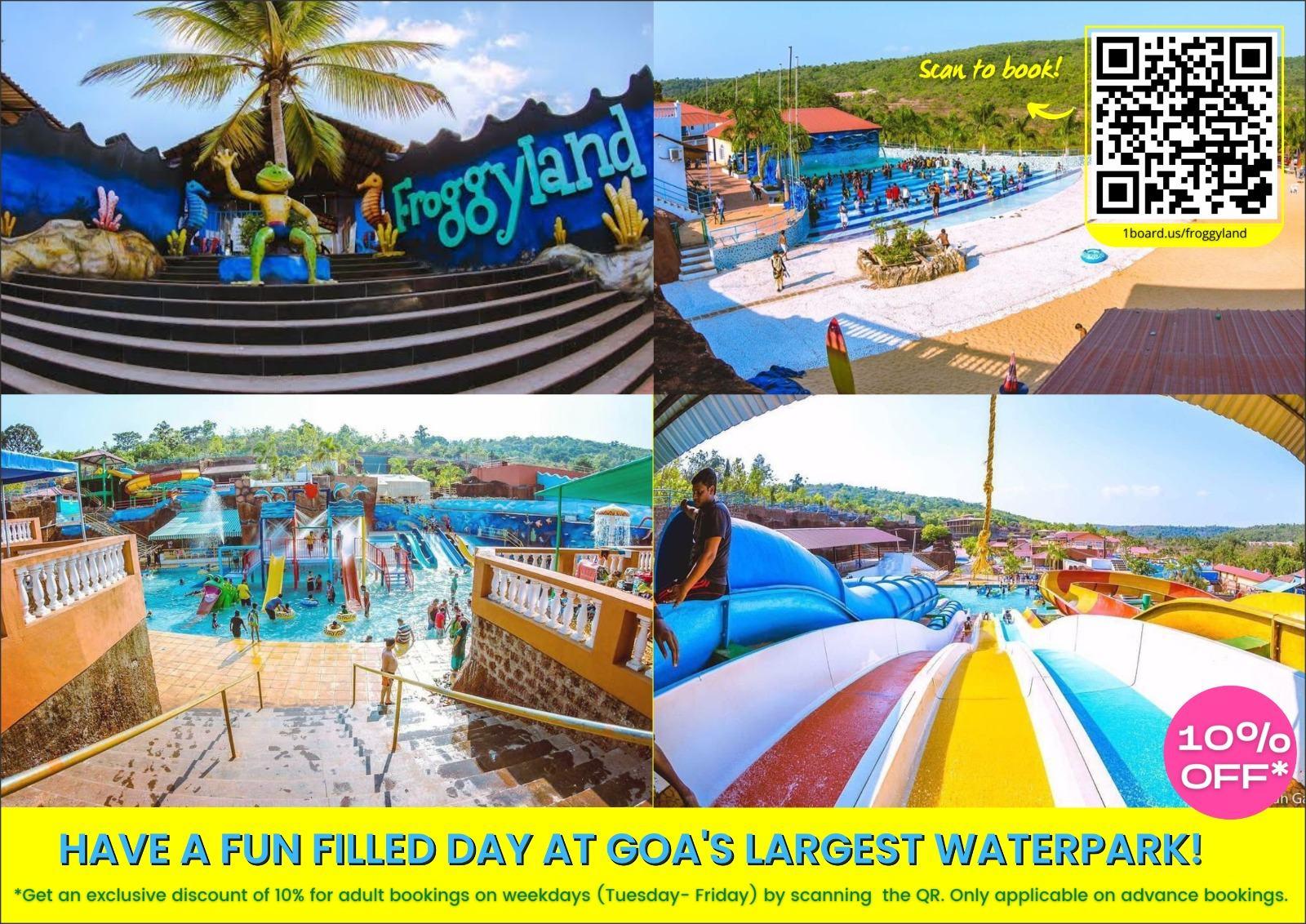
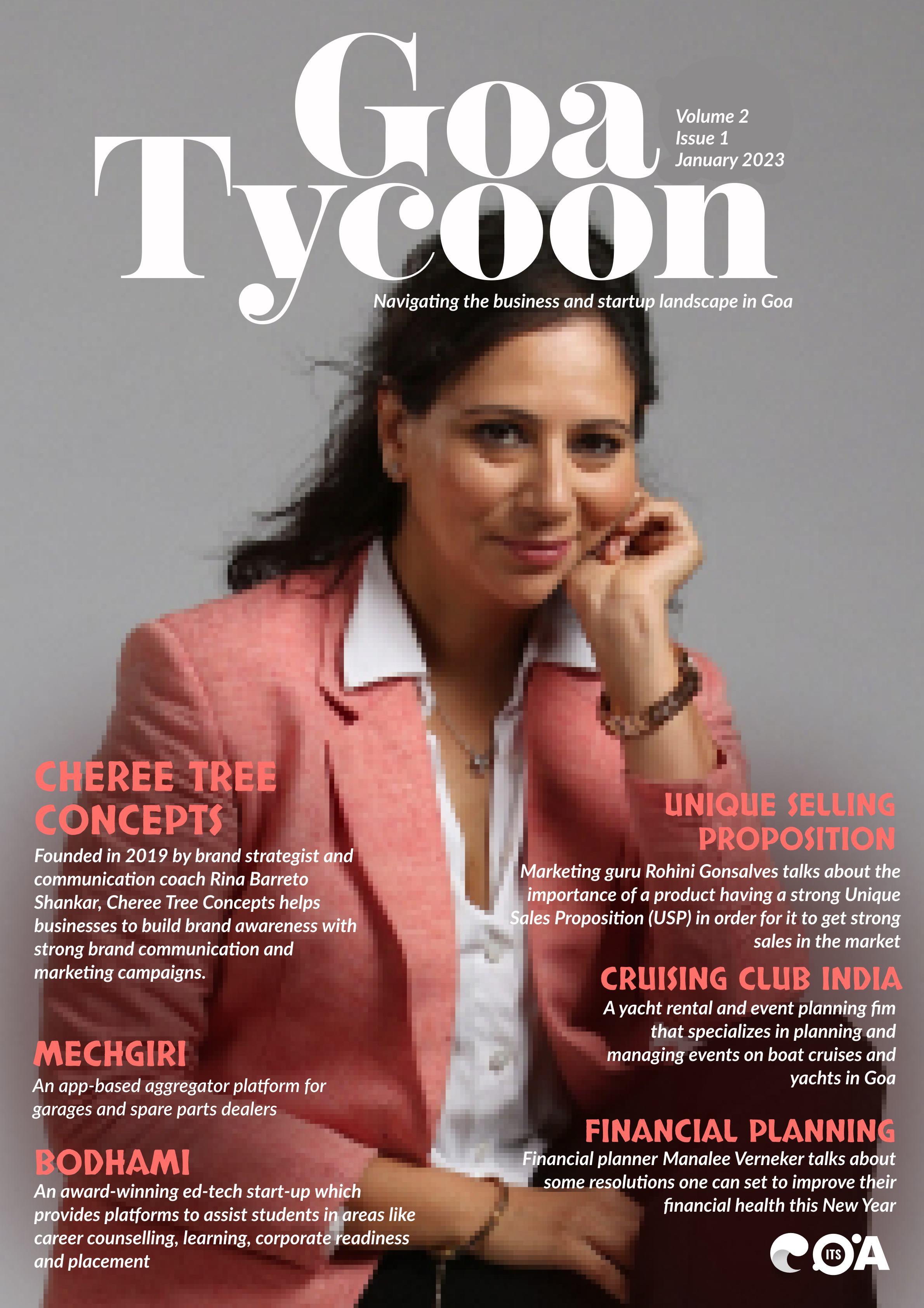

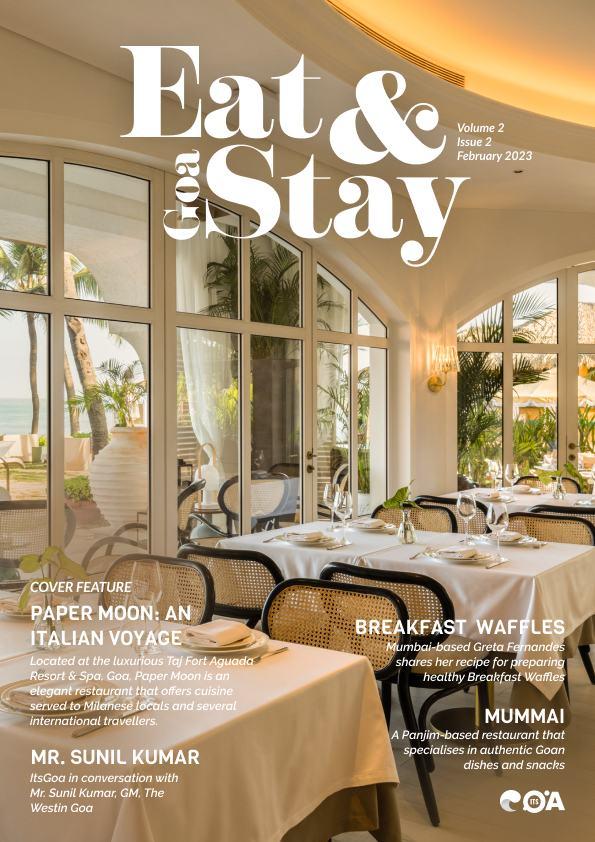

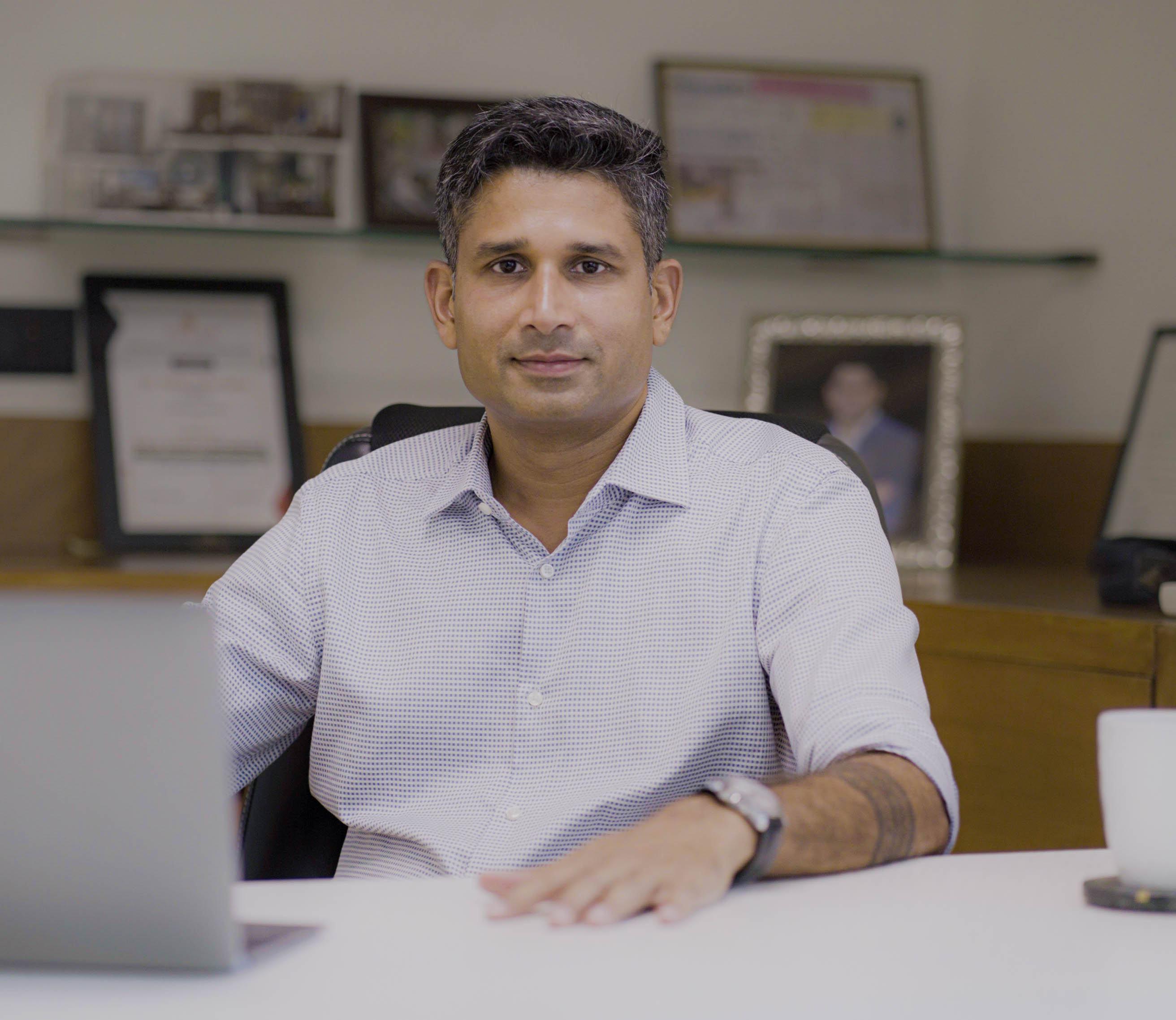
Parixit Pai Fondekar of Kamaxi Group emphasises skill-based education over degrees, urging India to align learning with real-world employability through practical, industry-driven, and future-ready training programs.
Article & Images by: Team ItsGoa
Why Skills Are the New Degree: Bridging India’s Skilling Gap
Amidst growing uncertainties in traditional education and the lack of skill-based learning, Parixit Pai Fondekar, founder of the Kamaxi Group, Verna, says it’s time we focus on preparing our youth for the jobs of today and not rely only on the theories of yesterday.
For generations, the Indian education system has glorified degrees; be it a bachelor’s or master’s degree, these were considered your ticket to success. Today, technology, globalisation and artificial intelligence have made that ticket redundant in securing job opportunities. The Economic Survey of 2025 revealed that over 53 percent of India’s graduates and 36 percent of postgraduates are underemployed, implying that they work in roles that don’t match up to their qualifications.
Another report by a major financial daily states that for every 10 open roles in generative AI, there's only one qualified engineer, highlighting a significant talent deficit in emerging technologies.
Herein lies a mismatch between education and employability. Traditional college curricula heavily focus on theoretics and seldom reflect the reality of modern workplaces. According to the India’s Graduate Skill Index 2025 by Mercer-Mettl, only 42.6 percent of Indian graduates are employable, because most lack the required job-ready talent.
The National Education Policy (NEP) 2020 had integrated vocational education into mainstream schooling, with the objective of empowering over 50 percent of secondary and tertiary students with vocational skills by 2025.
Recognising the crisis, the Government of India has rolled out several ambitious initiatives, including the Skill India Mission and the PM Vishwakarma Scheme. The Skill India Mission, launched in 2015, aimed to
train over 40 crore young people by 2022 in marketrelevant skills. However, as of 2023, only 1.4 crore youth were trained under its flagship scheme, the Pradhan Mantri Kaushal Vikas Yojana. On the other hand, launched in 2023, the PM Vishwakarma Scheme saw 24.77 lakh artisans register, in 2024, to receive crucial support in skill development, credit and market access.
Entrepreneurs are now crucial in bridging the skill gap and helping build a workforce fit for the 21st century, through innovative, industry-aligned, flexible learning models.
Skilling initiatives —born out of Goa’s booming hospitality scene— provide a model for outcomebased education. Such programmes, spanning three months to three years, allow students practical learning, from culinary techniques to entrepreneurship, food photography, social media marketing and business management.
Every programme is co-developed with industry professionals, ensuring real-world readiness. A hybrid model of learning, use of micro-credentials and internship-first approach is the kind of reform the skilling ecosystem needs.
A 25-year-old student, enrolled in our Bakery and Pastry Programme, aspired to work in France and specialise in French patisserie. While her interest began at home, her progress was fuelled by structured, skill-based learning — not just enthusiasm to chart a realistic path forward. Through hands-on training, industry exposure and entrepreneurial mentoring, she now has the tools to pursue her ambition with clarity and confidence.
The job market is shifting rapidly; the coming decade will demand digital skills that include a proficiency in AI, machine learning, cybersecurity and data analytics, green skills like sustainability, renewable energy and environmental stewardship, and soft skills like adaptability, critical thinking and problemsolving.
Despite its challenges, India’s skilling journey is at its crucial inflection with the newly refurbished Education Policy. Curricula will have evolved with input from industry experts, not just academia. Institutions must thus prioritise internships, apprenticeships and live projects instead of rote learning. Faculty with real-world experience and not just academic credentials is a must. Recognition of micro-credentials and skill certifications needs to be standardised across sectors.
The Indian youth, no longer satisfied with just degrees, are now looking for education that works. As the hospitality industry grapples with workforce shortages, both globally and locally, the focus must now shift to practical, flexible and future-proof
skilling. And programmes like Kamaxi Skills are showing how this can be done.
About the author: Parixit Pai Fondekar
With over 15 years’ experience in the recruitment and skill development sector for the global cruise and hospitality industry, Parixit Pai Fondekar, founded the Kamaxi Group, Goa.
The Group works across several verticals in the hospitality sector to ensure job-ready education, including Kamaxi College of Culinary Arts, India’s first Culinary Business School, Kamaxi Skills, Kamaxi Overseas Consultants, Kamaxi Maritime Academy and Fierce Kitchens, a culinary incubator.
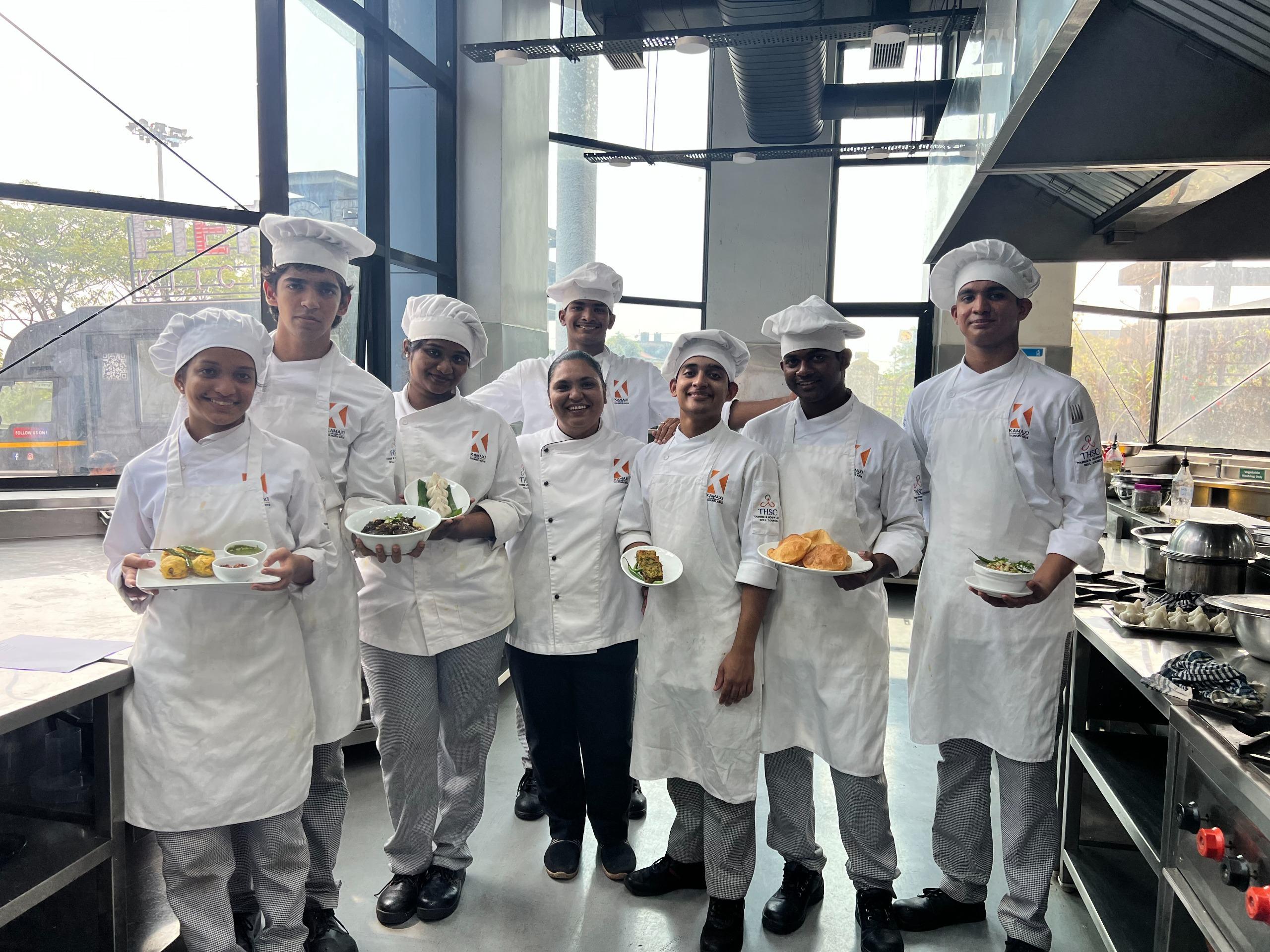

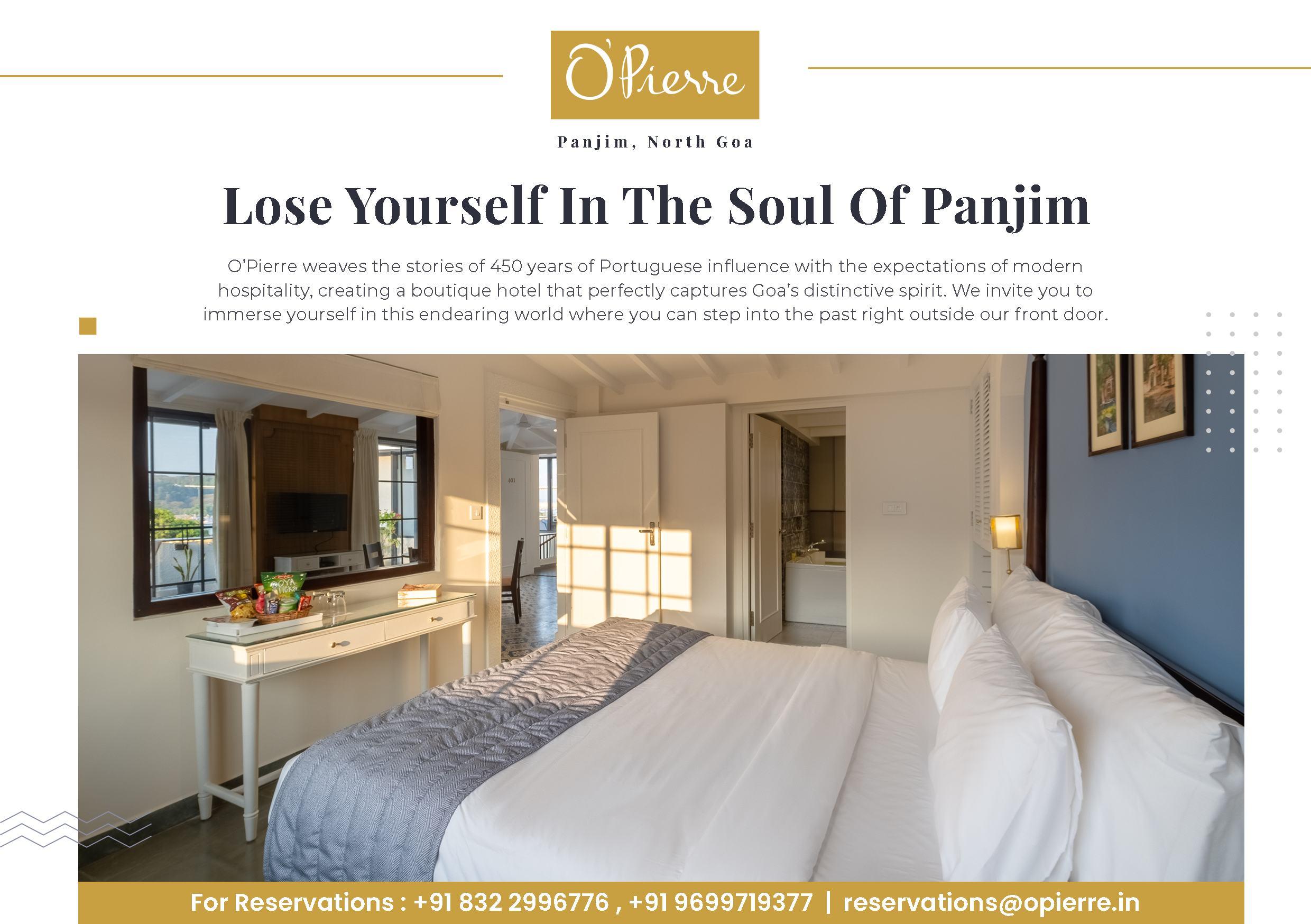

AUTHORED ARTICLE
Goa’s museums offer a window into its rich history, art, and culture — from ancient artefacts and naval exhibits to folk traditions and Christian art — making every visit a journey through time.
Goa, widely celebrated for its sun-drenched beaches and vibrant nightlife, also boasts a rich historical and cultural heritage. The state’s museums offer a fascinating glimpse into its colonial past, art, folklore, and natural history. From grand Portuguese-era collections to niche contemporary exhibits, Goa’s museums provide a journey that educates, inspires, and immerses visitors in the state’s unique legacy.
Located in Panaji, the Goa State Museum stands as a testament to the state’s rich cultural and historical past. The museum houses a vast collection of sculptures, coins, inscriptions, and paintings that trace Goa’s history from prehistoric times to the colonial era.
Visitors can marvel at intricately carved stone statues, rare manuscripts, and traditional artefacts that reflect the region’s artistic and architectural traditions.
Naval Aviation Museum – Tribute to Goa’s Military History
The Naval Aviation Museum in Vasco da Gama celebrates India’s naval aviation heritage. Featuring decommissioned aircraft, helicopters, and simulators, the museum offers an interactive experience for aviation enthusiasts.
Detailed exhibits highlight the evolution of naval operations and the contributions of the Indian Navy, making it an educational destination for families and history buffs alike.
Splendour
of Christian Art
Housed in Old Goa, the Museum of Christian Art showcases Goa’s colonial religious heritage. The museum’s collection includes sacred paintings, sculptures, and ornate relics that narrate the story of Christianity in the region.
Visitors can explore intricately designed altarpieces, liturgical artefacts, and centuries-old statues that reflect the fusion of European and Goan artistry.
Also located in Old Goa, the Archaeological Museum highlights Goa’s archaeological significance. With exhibits ranging from ancient pottery and coins to Roman-era artefacts, the museum sheds light on Goa’s historical trade routes, settlements, and cultural exchanges. Guided tours help visitors understand the evolution of the region over centuries.
The Big Foot Museum in Loutolim offers a more immersive experience by combining folk art, traditional Goan houses, and museum exhibits. It captures the essence of Goan rural life, from traditional occupations and crafts to cultural practices. This museum is ideal for travellers looking to understand everyday Goan traditions beyond the historical narratives of colonial rule.
Goa’s museums are more than mere repositories of artefacts. They are storytelling spaces that reveal the state’s diverse cultural, artistic, and historical identity. Whether you are an art lover, history enthusiast, or curious traveler. Exploring these museums provides context and depth to your Goan experience, connecting the present with centuries of tradition.
Plan visits in the morning when museums are less crowded.
Many museums offer guided tours—these enrich the experience by providing historical context. Combine museum visits with nearby attractions like churches, forts, and markets to make the most of your day. Carry a camera if permitted, as many exhibits provide perfect photo opportunities. Exploring Goa’s museums transforms a regular trip into a culturally enriching journey, revealing stories and treasures often overshadowed by the state’s beaches and parties. These museums not only preserve Goa’s past but also invite visitors to connect with the soul of this coastal paradise.
